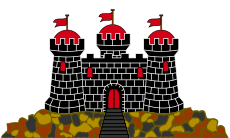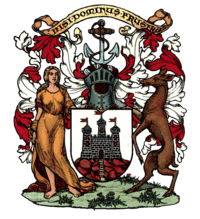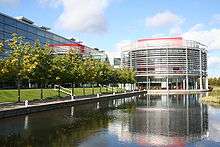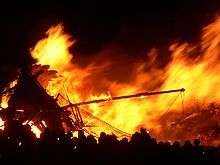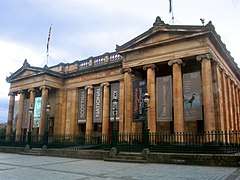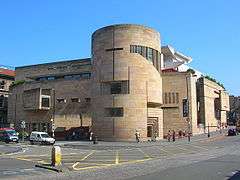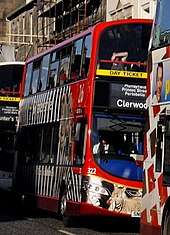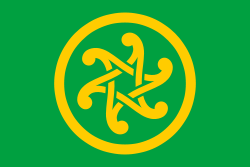Edinburgh
| Edinburgh Dùn Èideann | |||
|---|---|---|---|
| City and council area | |||
| City of Edinburgh | |||
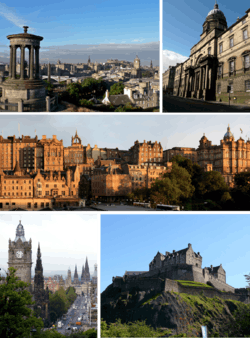 Clockwise from top-left: View from Calton Hill, Old College, Old Town from Princes Street, Edinburgh Castle, Princes Street from Calton Hill | |||
| |||
| Nickname(s): "Auld Reekie", "Edina", "Athens of the North" | |||
 Edinburgh Location of Edinburgh in Scotland  Edinburgh Edinburgh (the United Kingdom) 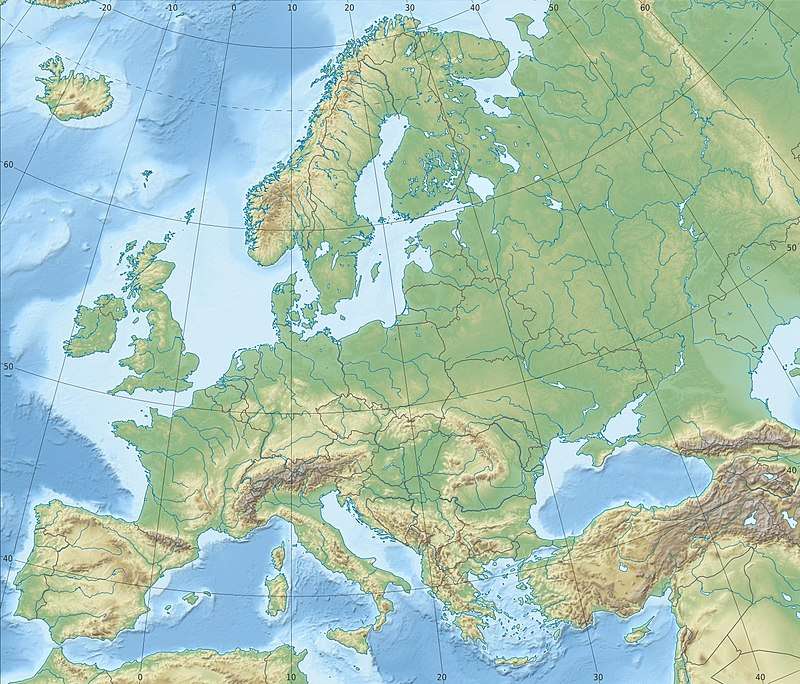 Edinburgh Edinburgh (Europe) | |||
| Coordinates: 55°57′11″N 3°11′20″W / 55.953°N 3.189°WCoordinates: 55°57′11″N 3°11′20″W / 55.953°N 3.189°W | |||
| Sovereign state |
| ||
| Country |
| ||
| Council area | City of Edinburgh | ||
| Lieutenancy area | Edinburgh | ||
| Founded | Prior to 7th century AD | ||
| Burgh Charter | 1125 | ||
| City status | 1889 | ||
| Government | |||
| • Type | Unitary authority | ||
| • Governing body | The City of Edinburgh Council | ||
| • Lord Provost of Edinburgh | Frank Ross | ||
| • MSPs |
| ||
| • MPs |
| ||
| Area | |||
| • City and council area | 264 km2 (102 sq mi) | ||
| Elevation[1] | 47 m (154 ft) | ||
| Population (2012 and 2016) | |||
| • City and council area | 464,990 – Locality [2] 513,210 – Local Authority Area[3] | ||
| • Density | 1,828/km2 (4,730/sq mi) | ||
| • Metro | 1,339,380 – Edinburgh & South East Scotland City Region:[3][4] | ||
| • Language(s) | English, Scots | ||
| Time zone | UTC±0 (GMT) | ||
| • Summer (DST) | UTC+1 (BST) | ||
| Postcode areas | EH1-17, EH28-30 | ||
| Area code(s) | 0131 | ||
| ISO 3166-2 | GB-EDH | ||
| ONS code | S12000036 | ||
| OS grid reference | NT275735 | ||
| NUTS 3 | UKM25 | ||
| Primary Airport | Edinburgh Airport | ||
| GDP | US$ 32.5 billion[5] | ||
| GDP per capita | US$ 58,437[5] | ||
| Website |
www | ||
| UNESCO World Heritage site | |||
| Official name | Old and New Towns of Edinburgh | ||
| Criteria | Cultural: ii, iv | ||
| Reference | 728 | ||
| Inscription | 1995 (19th Session) | ||
Edinburgh (/ˈɛdɪnbərə/ (![]()
Recognised as the capital of Scotland since at least the 15th century, Edinburgh is the seat of the Scottish Government, the Scottish Parliament and the supreme courts of Scotland. The city's Palace of Holyroodhouse is the official residence of the monarchy in Scotland. The city has long been a centre of education, particularly in the fields of medicine, Scots law, literature, the sciences and engineering. It is the second largest financial centre in the United Kingdom (after London)[9] and the city's historical and cultural attractions have made it the United Kingdom's second most popular tourist destination, attracting over one million overseas visitors each year.[10]
Edinburgh is Scotland's second most populous city and the seventh most populous in the United Kingdom. The official population estimates are 464,990 (2012) for the Locality of Edinburgh (Edinburgh pre 1975 regionalisation plus Currie and Balerno),[2] 513,210 (2017) for the City of Edinburgh,[3] and 1,339,380 (2014) for the city region.[3][4] Edinburgh lies at the heart of the Edinburgh and South East Scotland city region comprising East Lothian, Edinburgh, Fife, Midlothian, Scottish Borders and West Lothian.[11]
The city is the annual venue of the General Assembly of the Church of Scotland. It is home to national institutions such as the National Museum of Scotland, the National Library of Scotland and the Scottish National Gallery. The University of Edinburgh, founded in 1582 and now one of four in the city, is placed 18th in the QS World University Rankings for 2019.[12] The city is also famous for the Edinburgh International Festival and the Fringe, the latter being the world's largest annual international arts festival. Historic sites in Edinburgh include Edinburgh Castle, the Palace of Holyroodhouse, the churches of St. Giles, Greyfriars and the Canongate, and the extensive Georgian New Town, built in the 18th/19th centuries. Edinburgh's Old Town and New Town together are listed as a UNESCO World Heritage site,[13] which has been managed by Edinburgh World Heritage since 1999.
Etymology
"Edin", the root of the city's name, is most likely of Brittonic Celtic origin, from the Cumbric language or a variation of it that would have been spoken by the earliest known people of the area, an Iron Age tribe known to the Romans as the Votadini, and latterly in sub-Roman history as the Gododdin. It appears to derive from the place name Eidyn mentioned in the Old Welsh epic poem Y Gododdin.[14][15][16]
The poem names Din Eidyn as a hill fort (Din meaning "dun") in the territory of the Gododdin.[17] The change in nomenclature, from Din Eidyn to Edinburgh, reflects changes in the local language from Cumbric to Old English, the Germanic language of the Anglian kingdom of Bernicia that permeated the area from the mid-7th century and is regarded as the ancestor of modern Scots. The Celtic element din was dropped and replaced by the Old English burh.[18]
In modern Gaelic, the city is called Dùn Èideann (often rendered Dunedin by English-speakers).
Nicknames

The city is affectionately nicknamed Auld Reekie, Scots for Old Smoky, for the views from the country of the smoke-covered Old Town.
Allan Ramsay said, "Auld Reeky. A name the country people give Edinburgh from the cloud of smoke or reek that is always impending over it."[19]
Thomas Carlyle said, "Smoke cloud hangs over old Edinburgh,—for, ever since Aeneas Silvius's time and earlier, the people have the art, very strange to Aeneas, of burning a certain sort of black stones, and Edinburgh with its chimneys is called 'Auld Reekie' by the country people."[20]
A character in Walter Scott's, "The Abbot", says "... yonder stands Auld Reekie--you may see the smoke hover over her at twenty miles' distance."[21]
Robert Chambers who said that the sobriquet could not be traced before the reign of Charles II attributed the name to a Fife laird, Durham of Largo, who regulated the bedtime of his children by the smoke rising above Edinburgh from the fires of the tenements. "It's time now bairns, to tak' the beuks, and gang to our beds, for yonder's Auld Reekie, I see, putting on her nicht -cap!"[22]
Some have called Edinburgh the Athens of the North for a variety of reasons. The earliest comparison between the two cities showed that they had a similar topography, with the Castle Rock of Edinburgh performing a similar role to the Athenian Acropolis. Both of them had flatter, fertile agricultural land sloping down to a port several miles away (respectively Leith and Piraeus). Although this arrangement is common in Southern Europe, it is rare in Northern Europe. The 18th-century intellectual life, referred to as the Scottish Enlightenment, was a key influence in gaining the name. Such luminaries as David Hume and Adam Smith shone during this period. Having lost most of its political importance after the Union, some hoped that Edinburgh could gain a similar influence on London as Athens had on Rome. Also a contributing factor was the later neoclassical architecture, particularly that of William Henry Playfair, and the National Monument. Tom Stoppard's character Archie, of Jumpers, said, perhaps playing on Reykjavík meaning "smoky bay", that the "Reykjavík of the South" would be more appropriate.[23]
The city has also been known by several Latin names, such as Aneda or Edina. The adjectival form of the latter, Edinensis, can often be seen inscribed on educational buildings.[24][25]
The Scots poets Robert Fergusson and Robert Burns used the city's Latin name, Edina in their poems. Ben Jonson described it as "Britaine's other eye",[26] and Sir Walter Scott referred to it as "yon Empress of the North".[27] Robert Louis Stevenson, also a son of the city, wrote, "Edinburgh is what Paris ought to be".
The colloquial pronunciation "Embra" or "Embro" has also been used,[28] as in Robert Garioch's Embro to the Ploy.[29]
History
Early history
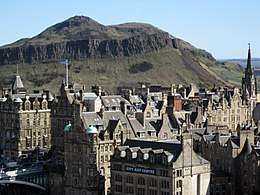
The earliest known human habitation in the Edinburgh area was at Cramond, where evidence was found of a Mesolithic camp site dated to c. 8500 BC.[30] Traces of later Bronze Age and Iron Age settlements have been found on Castle Rock, Arthur's Seat, Craiglockhart Hill and the Pentland Hills.[31]
When the Romans arrived in Lothian at the end of the 1st century AD, they found a Celtic Brittonic tribe whose name they recorded as the Votadini.[32] At some point before the 7th century AD, the Gododdin, who were presumably descendants of the Votadini, built the hill fort of Din Eidyn or Etin. Although its location has not been identified, it seems likely they would have chosen a commanding position such as the Castle Rock, Arthur's Seat, or Calton Hill.[33]
In 638, the Gododdin stronghold was besieged by forces loyal to King Oswald of Northumbria, and around this time control of Lothian passed to the Angles. Their influence continued for the next three centuries until around 950, when, during the reign of Indulf, son of Constantine II, the "burh" (fortress), named in the 10th-century Pictish Chronicle as oppidum Eden,[34] was abandoned to the Scots. It thenceforth remained under their jurisdiction.[35]
The royal burgh was founded by King David I in the early 12th century on land belonging to the Crown, though the date of its charter is unknown.[36] The first documentary evidence of the medieval burgh is a royal charter, c. 1124–1127, by King David I granting a toft in burgo meo de Edenesburg to the Priory of Dunfermline.[37] By the middle of the 14th century, the French chronicler Jean Froissart was describing it as the capital of Scotland (c. 1365), and James III (1451–88) referred to it in the 15th century as "the principal burgh of our kingdom".[38] Despite the destruction caused by an English assault in 1544, the town slowly recovered,[39] and was at the centre of events in the 16th-century Scottish Reformation[40] and 17th-century Wars of the Covenant.[41]
17th century
_by_Wenceslas_Hollar_(1670).jpg)
In 1603, King James VI of Scotland succeeded to the English throne, uniting the crowns of Scotland and England in a personal union known as the Union of the Crowns, though Scotland remained, in all other respects, a separate kingdom.[42] In 1638, King Charles I's attempt to introduce Anglican church forms in Scotland encountered stiff Presbyterian opposition culminating in the conflicts of the Wars of the Three Kingdoms.[43] Subsequent Scottish support for Charles Stuart's restoration to the throne of England resulted in Edinburgh's occupation by Oliver Cromwell's Commonwealth of England forces – the New Model Army – in 1650.[44]
In the 17th century, Edinburgh's boundaries were still defined by the city's defensive town walls. As a result, the city's growing population was accommodated by increasing the height of the houses. Buildings of 11 storeys or more were common,[45] and have been described as forerunners of the modern-day skyscraper.[46] Most of these old structures were replaced by the predominantly Victorian buildings seen in today's Old Town.
18th century
Following the Treaty of Union in 1706, the Parliaments of England and Scotland passed Acts of Union in 1706 and 1707 respectively, uniting the two kingdoms in the Kingdom of Great Britain effective from 1 May 1707.[47] As a consequence, the Parliament of Scotland merged with the Parliament of England to form the Parliament of Great Britain, which sat at Westminster in London. The Union was opposed by many Scots, resulting in riots in the city.[48]
By the first half of the 18th century, despite rising prosperity evidenced by its growing importance as a banking centre, Edinburgh was described as one of Europe's most densely populated, overcrowded and unsanitary towns.[49][50] Visitors were struck by the fact that the various social classes shared the same urban space, even inhabiting the same tenement buildings; although here a form of social segregation did prevail, whereby shopkeepers and tradesmen tended to occupy the cheaper-to-rent cellars and garrets, while the more well-to-do professional classes occupied the more expensive middle storeys.[51]

During the Jacobite rising of 1745, Edinburgh was briefly occupied by the Jacobite "Highland Army" before its march into England.[52] After its eventual defeat at Culloden, there followed a period of reprisals and pacification, largely directed at the rebellious clans.[53] In Edinburgh, the Town Council, keen to emulate London by initiating city improvements and expansion to the north of the castle,[54] reaffirmed its belief in the Union and loyalty to the Hanoverian monarch George III by its choice of names for the streets of the New Town: for example, Rose Street and Thistle Street; and for the royal family, George Street, Queen Street, Hanover Street, Frederick Street and Princes Street (in honour of George's two sons).[55]
In the second half of the century, the city was at the heart of the Scottish Enlightenment,[56] when thinkers like David Hume, Adam Smith, James Hutton and Joseph Black were familiar figures in its streets. Edinburgh became a major intellectual centre, earning it the nickname "Athens of the North" because of its many neo-classical buildings and reputation for learning, recalling ancient Athens.[57] In the 18th-century novel The Expedition of Humphry Clinker by Tobias Smollett one character describes Edinburgh as a "hotbed of genius".[58] Edinburgh was also a major centre for the Scottish book trade. The highly successful London bookseller Andrew Millar was apprenticed there to James McEuen.[59]
From the 1770s onwards, the professional and business classes gradually deserted the Old Town in favour of the more elegant "one-family" residences of the New Town, a migration that changed the city's social character. According to the foremost historian of this development, "Unity of social feeling was one of the most valuable heritages of old Edinburgh, and its disappearance was widely and properly lamented."[60]
19th and 20th centuries
| Wikisource has original text related to this article: |
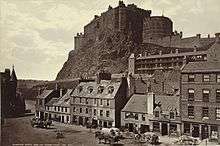
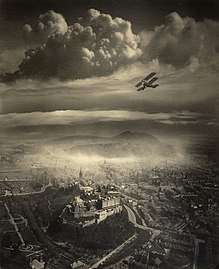
Although Edinburgh's traditional industries of printing, brewing and distilling continued to grow in the 19th century, and were joined by new rubber works and engineering works, there was little industrialisation compared with other cities in Britain. By 1821, Edinburgh had been overtaken by Glasgow as Scotland's largest city.[61] The city centre between Princes Street and George Street became a major commercial and shopping district, a development partly stimulated by the arrival of railways in the 1840s. The Old Town became an increasingly dilapidated, overcrowded slum with high mortality rates.[62] Improvements carried out under Lord Provost William Chambers in the 1860s began the transformation of the area into the predominantly Victorian Old Town seen today.[63] More improvements followed in the early 20th century as a result of the work of Patrick Geddes,[64] but relative economic stagnation during the two world wars and beyond saw the Old Town deteriorate further before major slum clearance in the 1960s and 1970s began to reverse the process. University building developments which transformed the George Square and Potterrow areas proved highly controversial.[65]
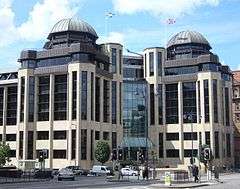
Since the 1990s a new "financial district", including the Edinburgh International Conference Centre, has grown mainly on demolished railway property to the west of the castle, stretching into Fountainbridge, a run-down 19th-century industrial suburb which has undergone radical change since the 1980s with the demise of industrial and brewery premises. This ongoing development has enabled Edinburgh to maintain its place as the United Kingdom's second largest financial and administrative centre after London.[66][67] Financial services now account for a third of all commercial office space in the city.[68] The development of Edinburgh Park, a new business and technology park covering 38 acres (15 ha), 4 mi (6 km) west of the city centre, has also contributed to the District Council's strategy for the city's major economic regeneration.[68]
In 1998, the Scotland Act, which came into force the following year, established a devolved Scottish Parliament and Scottish Executive (renamed the Scottish Government since September 2007[69]). Both based in Edinburgh, they are responsible for governing Scotland while reserved matters such as defence, taxation and foreign affairs remain the responsibility of the Parliament of the United Kingdom in London.[70]
Geography
Cityscape
Situated in Scotland's Central Belt, Edinburgh lies on the Firth of Forth's southern shore. The city centre is 2 1⁄2 miles (4.0 km) southwest of the shoreline of Leith and 26 miles (42 km) inland, as the crow flies, from the east coast of Scotland and the North Sea at Dunbar.[71] While the early burgh grew up near the prominent Castle Rock, the modern city is often said to be built on seven hills, namely Calton Hill, Corstorphine Hill, Craiglockhart Hill, Braid Hill, Blackford Hill, Arthur's Seat and the Castle Rock,[72] giving rise to allusions to the seven hills of Rome.[73]
Occupying a narrow gap between the Firth of Forth to the north and the Pentland Hills and their outrunners to the south, the city sprawls over a landscape which is the product of early volcanic activity and later periods of intensive glaciation. [74] Igneous activity between 350 and 400 million years ago, coupled with faulting, led to the creation of tough basalt volcanic plugs, which predominate over much of the area.[74] One such example is the Castle Rock which forced the advancing icesheet to divide, sheltering the softer rock and forming a 1-mile-long (1.6 km) tail of material to the east, thus creating a distinctive crag and tail formation.[74] Glacial erosion on the north side of the crag gouged a deep valley later filled by the now drained Nor Loch. These features, along with another hollow on the rock's south side, formed an ideal natural strongpoint upon which Edinburgh Castle was built.[74] Similarly, Arthur's Seat is the remains of a volcano dating from the Carboniferous period, which was eroded by a glacier moving west to east during the ice age.[74] Erosive action such as plucking and abrasion exposed the rocky crags to the west before leaving a tail of deposited glacial material swept to the east.[75] This process formed the distinctive Salisbury Crags, a series of teschenite cliffs between Arthur's Seat and the location of the early burgh.[76] The residential areas of Marchmont and Bruntsfield are built along a series of drumlin ridges south of the city centre, which were deposited as the glacier receded.[74]
Other prominent landforms such as Calton Hill and Corstorphine Hill are also products of glacial erosion.[74] The Braid Hills and Blackford Hill are a series of small summits to the city's south west that command expansive views looking northwards over the urban area to the Forth.[74]
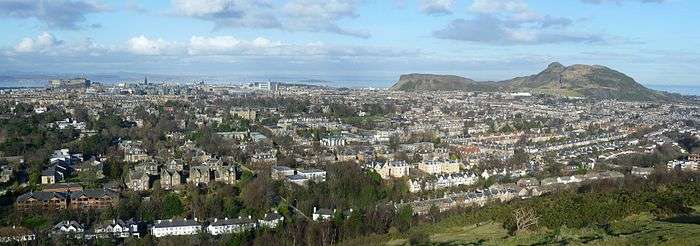
Edinburgh is drained by the river named the Water of Leith, which rises at the Colzium Springs in the Pentland Hills and runs for 29 kilometres (18 mi) through the south and west of the city, emptying into the Firth of Forth at Leith.[77] The nearest the river gets to the city centre is at Dean Village on the north-western edge of the New Town, where a deep gorge is spanned by Thomas Telford's Dean Bridge, built in 1832 for the road to Queensferry. The Water of Leith Walkway is a mixed use trail that follows the course of the river for 19.6 kilometres (12.2 mi) from Balerno to Leith.[78]

Excepting the shoreline of the Firth of Forth, Edinburgh is encircled by a green belt, designated in 1957, which stretches from Dalmeny in the west to Prestongrange in the east.[79] With an average width of 3.2 kilometres (2 mi) the principal objectives of the green belt were to contain the outward expansion of the city and to prevent the agglomeration of urban areas.[79] Expansion affecting the green belt is strictly controlled but developments such as Edinburgh Airport and the Royal Highland Showground at Ingliston lie within the zone.[79] Similarly, suburbs such as Juniper Green and Balerno are situated on green belt land.[79] One feature of the Edinburgh green belt is the inclusion of parcels of land within the city which are designated green belt, even though they do not connect with the peripheral ring. Examples of these independent wedges of green belt include Holyrood Park and Corstorphine Hill.[79]

Areas
Edinburgh comprises distinct areas that retain much of their original character as settlements in existence before they were absorbed into the sprawling city of the nineteenth century.[80] Many areas, such as Dalry contain residences that are multi-occupancy buildings known as tenements, although the more southern and western parts of the city have traditionally been more affluent with a greater number of detached and semi-detached villas.[81]

The historic centre of Edinburgh is divided in two by the broad green swathe of Princes Street Gardens. To the south the view is dominated by Edinburgh Castle, built high on Castle Rock, and the long sweep of the Old Town descending towards Holyrood Palace. To the north lie Princes Street and the New Town.
The West End includes the financial district, with insurance and banking offices as well as the Edinburgh International Conference Centre.
Edinburgh's Old and New Towns were listed as a UNESCO World Heritage Site in 1995 in recognition of the unique character of the Old Town with its medieval street layout and the planned Georgian New Town, including the adjoining Dean Village and Calton Hill areas. There are over 4,500 listed buildings within the city,[13] a higher proportion relative to area than any other city in the United Kingdom.
The Royal Mile runs downhill and terminates at Holyrood Palace. Minor streets (called closes or wynds) lie on either side of the main spine forming a herringbone pattern.[82] The street has several fine public buildings such as St Giles' Cathedral, the City Chambers and the Law Courts. Other places of historical interest nearby are Greyfriars Kirkyard and the Grassmarket. The street layout is typical of the old quarters of many northern European cities.
The castle perches on top of a rocky crag (the remnant of an extinct volcano) and the Royal Mile runs down the crest of a ridge from it. Due to space restrictions imposed by the narrowness of this landform, the Old Town became home to some of the earliest "high rise" residential buildings. Multi-storey dwellings known as lands were the norm from the 16th century onwards with ten and eleven storeys being typical and one even reaching fourteen or fifteen storeys.[83] Numerous vaults below street level were inhabited to accommodate the influx of incomers, particularly Irish immigrants, during the Industrial Revolution.
The New Town was an 18th-century solution to the problem of an increasingly crowded city which had been confined to the ridge sloping down from the castle. In 1766 a competition to design a "New Town" was won by James Craig, a 27-year-old architect.[84] The plan was a rigid, ordered grid, which fitted in well with Enlightenment ideas of rationality. The principal street was to be George Street, running along the natural ridge to the north of what became known as the "Old Town". To either side of it are two other main streets: Princes Street and Queen Street. Princes Street has become Edinburgh's main shopping street and now has few of its Georgian buildings in their original state. The three main streets are connected by a series of streets running perpendicular to them. The east and west ends of George Street are terminated by St Andrew Square and Charlotte Square respectively. The latter, designed by Robert Adam, influenced the architectural style of the New Town into the early 19th century.[85] Bute House, the official residence of the First Minister of Scotland, is on the north side of Charlotte Square.[86]
The hollow between the Old and New Towns was formerly the Nor Loch, which was created for the town's defence but came to be used by the inhabitants for dumping their sewage. It was drained by the 1820s as part of the city's northward expansion. Craig's original plan included an ornamental canal on the site of the loch,[55] but this idea was abandoned.[87] Soil excavated while laying the foundations of buildings in the New Town was dumped on the site of the loch to create the slope connecting the Old and New Towns known as The Mound.
In the middle of the 19th century the National Gallery of Scotland and Royal Scottish Academy Building were built on the Mound, and tunnels for the railway line between Haymarket and Waverley stations were driven through it.
The Southside is a popular residential part of the city, which includes the districts of St Leonards, Marchmont, Morningside, Newington, Sciennes, the Grange and Blackford. The Southside is broadly analogous to the area covered formerly by the Burgh Muir, and grew in popularity as a residential area after the opening of the South Bridge in the 1780s. The Southside is particularly popular with families (many state and private schools are here), young professionals and students (the central University of Edinburgh campus is based around George Square just north of Marchmont and the Meadows), and Napier University (with major campuses around Merchiston and Morningside). The area is also well provided with hotel and "bed and breakfast" accommodation for visiting festival-goers. These districts often feature in works of fiction. For example, Church Hill in Morningside, was the home of Muriel Spark's Miss Jean Brodie,[88] and Ian Rankin's Inspector Rebus lives in Marchmont and works in St Leonards.[89]
Leith was historically the port of Edinburgh, an arrangement of unknown date that was confirmed by the royal charter Robert the Bruce granted to the city in 1329.[90] The port developed a separate identity from Edinburgh, which to some extent it still retains, and it was a matter of great resentment when the two burghs merged in 1920 into the City of Edinburgh.[91] Even today the parliamentary seat is known as "Edinburgh North and Leith". The loss of traditional industries and commerce (the last shipyard closed in 1983) resulted in economic decline.[92] The Edinburgh Waterfront development has transformed old dockland areas from Leith to Granton into residential areas with shopping and leisure facilities and helped rejuvenate the area. With the redevelopment, Edinburgh has gained the business of cruise liner companies which now provide cruises to Norway, Sweden, Denmark, Germany, and the Netherlands.
The coastal suburb of Portobello is characterised by Georgian villas, Victorian tenements, a popular beach and promenade and cafés, bars, restaurants and independent shops. There are rowing and sailing clubs and a restored Victorian swimming pool, including Turkish baths.
The urban area of Edinburgh is almost entirely within the City of Edinburgh Council boundary, merging with Musselburgh in East Lothian. Towns within easy reach of the city boundary include Haddington, Tranent, Prestonpans, Dalkeith, Bonnyrigg, Loanhead, Penicuik, Broxburn, Livingston and Dunfermline. Edinburgh lies at the heart of the Edinburgh & South East Scotland City region with a population in 2014 of 1,339,380.[3][4]
Climate
Like most of Scotland, Edinburgh has a temperate, maritime climate which is relatively mild despite its northerly latitude.[93] Winter daytime temperatures rarely fall below freezing and are milder than places such as Moscow and Labrador which lie at similar latitudes.[93] Summer temperatures are normally moderate, rarely exceeding 22 °C (72 °F).[93] The highest temperature ever recorded in the city was 31.4 °C (88.5 °F) on 4 August 1975[93] at Turnhouse Airport. The lowest temperature recorded in recent years was −14.6 °C (5.7 °F) during December 2010 at Gogarbank.[94] In an average year, the temperature will drop to a minimum of −7.3 °C (18.9 °F).[95]
The city's proximity to the sea mitigates any large variations in temperature or extremes of climate. Given Edinburgh's position between the coast and hills, it is renowned as "the windy city", with the prevailing wind direction coming from the south west, which is often associated with warm, unstable air from the North Atlantic Current that can give rise to rainfall – although considerably less than cities to the west, such as Glasgow.[93] Rainfall is distributed fairly evenly throughout the year.[93] Winds from an easterly direction are usually drier but considerably colder, and may be accompanied by haar, a persistent coastal fog. Vigorous Atlantic depressions, known as European windstorms, can affect the city between October and May.[93]
There is also a weather station in Gogarbank on the city's outskirts.[96] This slightly inland station has a slightly wider temperature span between seasons, is cloudier and somewhat wetter, but differences are minor.
| Climate data for Edinburgh (Royal Botanic Gardens) | |||||||||||||
|---|---|---|---|---|---|---|---|---|---|---|---|---|---|
| Month | Jan | Feb | Mar | Apr | May | Jun | Jul | Aug | Sep | Oct | Nov | Dec | Year |
| Record high °C (°F) | 15.0 (59) |
15.2 (59.4) |
20.0 (68) |
22.8 (73) |
29.0 (84.2) |
27.8 (82) |
30.0 (86) |
31.4 (88.5) |
26.7 (80.1) |
24.4 (75.9) |
20.6 (69.1) |
15.4 (59.7) |
31.4 (88.5) |
| Average high °C (°F) | 7.0 (44.6) |
7.5 (45.5) |
9.5 (49.1) |
11.8 (53.2) |
14.7 (58.5) |
17.2 (63) |
19.1 (66.4) |
18.9 (66) |
16.5 (61.7) |
13.1 (55.6) |
9.6 (49.3) |
7.0 (44.6) |
12.7 (54.8) |
| Average low °C (°F) | 1.4 (34.5) |
1.5 (34.7) |
2.8 (37) |
4.3 (39.7) |
6.8 (44.2) |
9.7 (49.5) |
11.5 (52.7) |
11.4 (52.5) |
9.4 (48.9) |
6.5 (43.7) |
3.7 (38.7) |
1.3 (34.3) |
5.9 (42.5) |
| Record low °C (°F) | −15.5 (4.1) |
−11.7 (10.9) |
−11.1 (12) |
−6.1 (21) |
−2.4 (27.7) |
1.1 (34) |
4.4 (39.9) |
2.2 (36) |
−1.1 (30) |
−3.7 (25.3) |
−8.3 (17.1) |
−11.5 (11.3) |
−15.5 (4.1) |
| Average precipitation mm (inches) | 67.5 (2.657) |
47.0 (1.85) |
51.7 (2.035) |
40.5 (1.594) |
48.9 (1.925) |
61.3 (2.413) |
65.0 (2.559) |
60.2 (2.37) |
63.7 (2.508) |
75.6 (2.976) |
62.1 (2.445) |
60.8 (2.394) |
704.3 (27.726) |
| Average rainy days | 12.5 | 9.4 | 9.9 | 8.8 | 9.6 | 9.6 | 9.5 | 9.7 | 10.2 | 12.4 | 11.2 | 11.4 | 124.2 |
| Mean monthly sunshine hours | 53.5 | 78.5 | 114.8 | 144.6 | 188.4 | 165.9 | 172.2 | 161.5 | 128.8 | 101.2 | 71.0 | 46.2 | 1,426.6 |
| Source: Met Office[97] | |||||||||||||
| Climate data for Edinburgh/Gogarbank | |||||||||||||
|---|---|---|---|---|---|---|---|---|---|---|---|---|---|
| Month | Jan | Feb | Mar | Apr | May | Jun | Jul | Aug | Sep | Oct | Nov | Dec | Year |
| Average high °C (°F) | 6.6 (43.9) |
7.0 (44.6) |
9.0 (48.2) |
11.6 (52.9) |
14.6 (58.3) |
17.2 (63) |
19.2 (66.6) |
19.1 (66.4) |
16.6 (61.9) |
12.9 (55.2) |
9.2 (48.6) |
6.6 (43.9) |
12.5 (54.5) |
| Average low °C (°F) | 1.1 (34) |
1.3 (34.3) |
2.6 (36.7) |
4.1 (39.4) |
6.5 (43.7) |
9.1 (48.4) |
10.9 (51.6) |
10.8 (51.4) |
9.2 (48.6) |
6.2 (43.2) |
3.6 (38.5) |
1.1 (34) |
5.6 (42.1) |
| Average precipitation mm (inches) | 76.3 (3.004) |
53.8 (2.118) |
55.9 (2.201) |
46.1 (1.815) |
49.0 (1.929) |
61.5 (2.421) |
64.1 (2.524) |
67.8 (2.669) |
58.0 (2.283) |
84.5 (3.327) |
73.7 (2.902) |
63.6 (2.504) |
754.2 (29.693) |
| Average rainy days | 13.6 | 9.8 | 11.8 | 9.8 | 11.4 | 10.4 | 10.2 | 11.2 | 10.4 | 12.8 | 13.0 | 12.9 | 137.2 |
| Mean monthly sunshine hours | 45.5 | 69.6 | 106.9 | 136.3 | 188.3 | 154.1 | 170.7 | 149.0 | 125.5 | 96.1 | 65.2 | 35.3 | 1,342.7 |
| Source: Met Office[98] | |||||||||||||
Demography
Current
| Edinburgh compared[99][100] | ||
|---|---|---|
| UK Census 2011 | Edinburgh | Scotland |
| Total population | 476,626 | 5,295,000 |
| Population growth 2001–2011 | 6.2% | 5.0% |
| White | 91.7% | 96.0% |
| Asian | 5.5% | 2.7% |
| Black | 1.4% | 0.8% |
| Christian | 43.0% | 54.0% |
| Muslim | 2.6% | 1.4% |
The most recent official population estimates are 464,990 (2012) for the Edinburgh Locality[2] and 507,170 (2016) for the local authority area.[3] Edinburgh lies at the heart of the Edinburgh & South East Scotland City region with a population in 2014 of 1,339,380.[3][4] This makes Edinburgh Scotland's second largest city after Glasgow and the seventh largest in Britain.
Edinburgh has a high proportion of young adults, with 19.5% of the population in their 20s (exceeded only by Aberdeen) and 15.2% in their 30s which is the highest in Scotland. The proportion of Edinburgh's population born in the UK fell from 92% to 84% between 2001 and 2011, while the proportion born in Scotland fell from 78% to 70%. Of those Edinburgh residents born in the UK, 335,000 or 83% were born in Scotland, with 58,000 or 14% being born in England.[101]
The proportion of people born outside the UK was 15.9% comparing with 8% in 2001. Countries accounting for the largest number of Edinburgh citizens born overseas are: Poland (13,000), Republic of Ireland (8,603), China (8,076), India (6,470), Pakistan (5,858), United States (3,700), Germany (3,500), Australia (2,100), France (2,000) Spain (2,000), South Africa (1,800) and Canada (1,800). 47% of the non-UK-born population in Edinburgh is of European origin, which is amongst the highest for any UK city.[101]
Some 13,000 people or 2.7% of the city's population are Polish. 39,500 people or 8.2% of Edinburgh's population class themselves as Non-White which is an increase from 4% in 2001. Of the Non-White population, the largest group by far are Asian, totalling 26,264 people. Within the Asian population, the Chinese are now the largest sub-group, with 8,076 people, amounting to about 1.7% of the city's total population. The city's Indian population amounts to 6,470 (1.4% of the total population), while there are some 5,858 Pakistanis (1.2% of the total population). Although they account for only 1,277 people or 0.3% of the city's population, Edinburgh has the highest number and proportion of Bangladeshis in Scotland. Over 7,000 people were born in African countries (1.6% of the total population) and nearly 7,000 in the Americas. With the notable exception of Inner London, Edinburgh has a higher number of people born in the United States (over 3,700) than any other city in the UK.[101]
Historical
| Historical population | ||
|---|---|---|
| Year | Pop. | ±% |
| 1801 | 82,560 | — |
| 1811 | 102,987 | +24.7% |
| 1821 | 138,235 | +34.2% |
| 1831 | 161,909 | +17.1% |
| 1841 | 166,450 | +2.8% |
| 1851 | 193,929 | +16.5% |
| 1901 | 303,638 | +56.6% |
| 1911 | 320,318 | +5.5% |
| 1921 | 420,264 | +31.2% |
| 1931 | 439,010 | +4.5% |
| 1951 | 466,761 | +6.3% |
| Source: [102] | ||
A census by the Edinburgh presbytery in 1592 recorded a population of 8,003 adults spread equally north and south of the High Street which runs along the spine of the ridge sloping down from the Castle.[103] In the 18th and 19th centuries, the population expanded rapidly, rising from 49,000 in 1751 to 136,000 in 1831, primarily due to migration from rural areas.[104] As the population grew, problems of overcrowding in the Old Town, particularly in the cramped tenements that lined the present day Royal Mile and the Cowgate, were exacerbated.[104] Poor sanitary arrangements resulted in a high incidence of disease,[104] with outbreaks of cholera occurring in 1832, 1848 and 1866.[105]
The construction of the New Town from 1767 onwards witnessed the migration of the professional and business classes from the difficult living conditions in the Old Town to the lower density, higher quality surroundings taking shape on land to the north. [106] Expansion southwards from the Old Town saw more tenements being built in the 19th century, giving rise to Victorian suburbs such as Dalry, Newington, Marchmont and Bruntsfield.[106]
Early 20th century population growth coincided with lower-density suburban development. As the city expanded to the south and west, detached and semi-detached villas with large gardens replaced tenements as the predominant building style. Nonetheless, the 2001 census revealed that over 55% of Edinburgh's population were still living in tenements or blocks of flats, a figure in line with other Scottish cities, but much higher than other British cities, and even central London.[107]
From the early to mid 20th century the growth in population, together with slum clearance in the Old Town and other areas, such as Dumbiedykes, Leith, and Fountainbridge, led to the creation of new estates such as Stenhouse and Saughton, Craigmillar and Niddrie, Pilton and Muirhouse, Piershill, and Sighthill.[108]
Religion
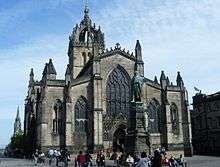
The Church of Scotland claims the largest membership of any single religious denomination in Edinburgh. In 2010 there were 83 congregations in the Presbytery of Edinburgh.[109] Its most prominent church is St Giles' on the Royal Mile, first dedicated in 1243 but believed to date from before the 12th century.[110] Saint Giles is historically the patron saint of Edinburgh.[111] St Cuthbert's, situated at the west end of Princes Street Gardens in the shadow of Edinburgh Castle and St Giles' can lay claim to being the oldest Christian sites in the city,[112] though the present St Cuthbert's, designed by Hippolyte Blanc, was dedicated in 1894.[113]
Other Church of Scotland churches include Greyfriars Kirk, the Canongate Kirk, St Andrew's and St George's West Church and the Barclay Church. The Church of Scotland Offices are in Edinburgh,[114] as is the Assembly Hall where the annual General Assembly is held.[115]
The Roman Catholic Archdiocese of St Andrews and Edinburgh has 27 parishes across the city.[116] The Archbishop of St Andrews and Edinburgh has his official residence in Greenhill,[117] and the diocesan offices are in nearby Marchmont.[118] The Diocese of Edinburgh of the Scottish Episcopal Church has over 50 churches, half of them in the city.[119] Its centre is the late 19th century Gothic style St Mary's Cathedral in the West End's Palmerston Place.[120] Orthodox christianity is represented by Pan, Romanian and Russian Orthodox churches. There are several independent churches in the city, both Catholic and Protestant, including Charlotte Chapel, Carrubbers Christian Centre, Bellevue Chapel and Sacred Heart.[121] There are also churches belonging to Quakers, Christadelphians,[122] Seventh-day Adventists, Church of Christ, Scientist and The Church of Jesus Christ of Latter-day Saints (LDS Church).
Edinburgh Central Mosque – Edinburgh's main mosque and Islamic Centre – is in Potterrow, on the city's Southside, near Bristo Square. Construction was largely financed by a gift from King Fahd of Saudi Arabia[123] and was completed in 1998. There are other mosques in Annandale Street Lane, off Leith Walk, and in Queensferry Road, Blackhall as well as other Islamic centres across the city.[124] There is also an active presence of the Ahmadiyya Muslim community.[125] The first recorded presence of a Jewish community in Edinburgh dates back to the late 18th century.[126] Edinburgh's Orthodox synagogue, opened in 1932, is in Salisbury Road and can accommodate a congregation of 2000. A Liberal Jewish congregation also meets in the city. There are a Sikh gurdwara and a Hindu mandir, both in Leith, and a Brahma Kumaris centre[127] in the Polwarth area. The Edinburgh Buddhist Centre, run by the Triratna Buddhist Community, formerly situated in Melville Terrace, now runs sessions at the Healthy Life Centre, Bread Street.[128] Other Buddhist traditions are represented by groups which meet in the capital: the Community of Interbeing (followers of Thich Nhat Hanh), Rigpa, Samye Dzong, Theravadin, Pure Land and Shambala. There is a Sōtō Zen Priory in Portobello[129] and a Theravadin Thai Buddhist Monastery in Slateford Road.[130] Edinburgh is home to an active Bahá'í Community,[131] and a Theosophical Society meets in Great King Street.[132] Edinburgh has an active Inter-Faith Association.[133]
Economy
Edinburgh has the strongest economy of any city in the United Kingdom outside London and the highest percentage of professionals in the UK with 43% of the population holding a degree-level or professional qualification.[134] According to the Centre for International Competitiveness, it is the most competitive large city in the United Kingdom.[135] It also has the highest gross value added per employee of any city in the UK outside London, measuring £57,594 in 2010.[136] It was named European Best Large City of the Future for Foreign Direct Investment and Best Large City for Foreign Direct Investment Strategy in the Financial Times fDi magazine awards 2012/13.
In the 19th century, Edinburgh's economy was known for banking, publishing and brewing. Today, its economy is based mainly on financial services, scientific research, higher education, and tourism.[137] In March 2010, unemployment in Edinburgh was comparatively low at 3.6%, and it remains consistently below the Scottish average of 4.5%.[138] Edinburgh is the 2nd most visited city by foreign visitors in the UK after London.
Banking has been a mainstay of the Edinburgh economy for over 300 years, since the Bank of Scotland (now part of the Lloyds Banking Group) was established by an act of the Scottish Parliament in 1695. Today, the financial services industry, with its particularly strong insurance and investment sectors, and underpinned by Edinburgh-based firms such as Scottish Widows and Standard Life, accounts for the city being the UK's second financial centre after London and Europe's fourth in terms of equity assets.[139] The Royal Bank of Scotland opened new global headquarters at Gogarburn in the west of the city in October 2005, and Edinburgh is home to the headquarters of Bank of Scotland, Sainsbury's Bank,[140] Tesco Bank,[141] TSB Bank and Virgin Money.[142]
Tourism is also an important element in the city's economy. As a World Heritage Site, tourists visit historical sites such as Edinburgh Castle, the Palace of Holyroodhouse and the Old and New Towns. Their numbers are augmented in August each year during the Edinburgh Festivals, which attracts 4.4 million visitors,[138] and generates over £100m for the local economy.[143]
As the centre of Scotland's government and legal system, the public sector plays a central role in Edinburgh's economy. Many departments of the Scottish Government are in the city. Other major employers include NHS Scotland and local government administration.[137]
Culture
Festivals and celebrations
Edinburgh festival
The city hosts a series of festivals that run between the end of July and early September each year. The best known of these events are the Edinburgh Festival Fringe, the Edinburgh International Festival, the Edinburgh Military Tattoo and the Edinburgh International Book Festival.[144]
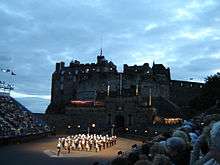
The longest established of these festivals is the Edinburgh International Festival, which was first held in 1947[145] and consists mainly of a programme of high-profile theatre productions and classical music performances, featuring international directors, conductors, theatre companies and orchestras.[146]
This has since been overtaken both in size and popularity by the Edinburgh Fringe which began as a programme of marginal acts alongside the "official" Festival and has become the world's largest performing arts festival. In 2017, nearly 3400 different shows were staged in 300 venues across the city.[147][148] Comedy has become one of the mainstays of the Fringe, with numerous well-known comedians getting their first 'break' there, often by being chosen to receive the Edinburgh Comedy Award.[149] The Edinburgh Military Tattoo, occupies the Castle Esplanade every night for three weeks each August, with massed pipe bands and military bands drawn from around the world. Performances end with a short fireworks display.
As well as the various summer festivals, many other festivals are held during the rest of the year, including the Edinburgh International Film Festival[150] and Edinburgh International Science Festival.[151]
Edinburgh's Hogmanay
The annual Edinburgh Hogmanay celebration was originally an informal street party focused on the Tron Kirk in the Old Town's High Street. Since 1993, it has been officially organised with the focus moved to Princes Street. In 1996, over 300,000 people attended, leading to ticketing of the main street party in later years up to a limit of 100,000 tickets.[152] Hogmanay now covers four days of processions, concerts and fireworks, with the street party beginning on Hogmanay. Alternative tickets are available for entrance into the Princes Street Gardens concert and Cèilidh, where well-known artists perform and ticket holders can participate in traditional Scottish cèilidh dancing. The event attracts thousands of people from all over the world.[152]
On the night of 30 April the Beltane Fire Festival takes place on Calton Hill, involving a procession followed by scenes inspired by pagan old spring fertility celebrations.[153] At the beginning of October each year the Dussehra Hindu Festival is also held on Calton Hill.[154]
Music, theatre and film
Outside the Festival season, Edinburgh supports several theatres and production companies. The Royal Lyceum Theatre has its own company, while the King's Theatre, Edinburgh Festival Theatre and Edinburgh Playhouse stage large touring shows. The Traverse Theatre presents a more contemporary repertoire. Amateur theatre companies productions are staged at the Bedlam Theatre, Church Hill Theatre and King's Theatre among others.[155]
The Usher Hall is Edinburgh's premier venue for classical music, as well as occasional popular music concerts.[156] It was the venue for the Eurovision Song Contest 1972. Other halls staging music and theatre include The Hub, the Assembly Rooms and the Queen's Hall. The Scottish Chamber Orchestra is based in Edinburgh.[157]
Edinburgh has two repertory cinemas, the Edinburgh Filmhouse and The Cameo, as well as the independent Dominion Cinema and a range of multiplexes.[158]
Edinburgh has a healthy popular music scene. Occasionally large concerts are staged at Murrayfield and Meadowbank, while mid-sized events take place at smaller venues such as the Corn Exchange, the Liquid Rooms and the Bongo Club. In 2010, PRS for Music listed Edinburgh among the UK's top ten 'most musical' cities.[159] Several city pubs are well known for their live performances of folk music. They include 'Sandy Bell's' in Forrest Road, 'The Captain's Bar' in South College Street, and 'Whistlebinkies' in South Bridge.
Edinburgh is home to a flourishing group of contemporary composers such as Nigel Osborne, Peter Nelson, Lyell Cresswell, Hafliði Hallgrímsson, Edward Harper, Robert Crawford, Robert Dow and John McLeod. McLeod's music is heard regularly on BBC Radio 3 and throughout the UK.[160]
Rockstar North, formerly DMA Design, known for creating the Grand Theft Auto series, is based in Edinburgh.[161]
Media
The Edinburgh Evening News is based in Edinburgh and published every day except Sunday. Johnston Press owns the title and The Scotsman; their corporate headquarters are in Edinburgh and their national newspaper is the only one published in the city.[162]
The city has two commercial radio stations: Forth 1, a station which broadcasts mainstream chart music, and Forth 2 on medium wave which plays classic hits.[163] Capital Radio Scotland and Eklipse Sports Radio also have transmitters covering Edinburgh. Along with the UK national radio stations, Radio Scotland and the Gaelic language service BBC Radio nan Gàidheal are also broadcast. DAB digital radio is broadcast over two local multiplexes. BFBS Radio broadcasts from studios on the base at Dreghorn Barracks across the city on 98.5FM as part of its UK Bases network
STV Edinburgh, a local TV channel for the city, launched on 12 January 2015.[164] Television, along with most radio services, is broadcast to the city from the Craigkelly transmitting station situated in Fife on the opposite side of the Firth of Forth.[165]
Museums, libraries and galleries
Edinburgh has many museums and libraries. These include the National Museum of Scotland, the National Library of Scotland, National War Museum, the Museum of Edinburgh, Surgeons' Hall Museum, the Writers' Museum, the Museum of Childhood and Our Dynamic Earth. The Museum on the Mound has exhibits on money and banking.[166]
Edinburgh Zoo, covering 82 acres (33 ha) on Corstorphine Hill, is the second most popular paid tourist attraction in Scotland,[167] and currently home to two giant pandas, Tian Tian and Yang Guang, on loan from the People's Republic of China.
Edinburgh is also home to The Royal Yacht Britannia, decommissioned in 1997 and now a five-star visitor attraction and evening events venue permanently berthed at Ocean Terminal.
Edinburgh contains Scotland's five National Galleries of Art as well as numerous smaller art galleries.[168] The national collection is housed in the National Gallery of Scotland, located on the Mound, now linked to the Royal Scottish Academy which holds regular major exhibitions of paintings. Contemporary collections are shown in the Scottish National Gallery of Modern Art which occupies a split site at Belford. The Scottish National Portrait Gallery on Queen Street focuses on portraits and photography.
The council-owned City Art Centre in Market Street mounts regular art exhibitions. Across the road, The Fruitmarket Gallery offers world class exhibitions of contemporary art, featuring work by British and international artists with both emerging and established international reputations.[169]
There are many small private galleries, including the Ingleby Gallery. This provides a varied programme including shows by Callum Innes, Peter Liversidge, Ellsworth Kelly, Richard Forster, and Sean Scully.[170]
The city hosts several of Scotland's galleries and organisations dedicated to contemporary visual art. Significant strands of this infrastructure include: The Scottish Arts Council, Edinburgh College of Art, Talbot Rice Gallery (University of Edinburgh) and the Edinburgh Annuale.
Shopping
The locale around Princes Street is the main shopping area in the city centre, with souvenir shops, chain stores such as Boots the Chemist, H&M and Jenners.[171] George Street, north of Princes Street, is the preferred location for some upmarket shops and independent stores.[171] The St. James Centre at the east end of Princes Street is currently being redeveloped, however the John Lewis store remains open.[172] Multrees Walk, adjacent to the St. James Centre, is a recent addition to the central shopping district, dominated by the presence of Harvey Nichols. Shops here include Louis Vuitton, Mulberry and Calvin Klein.[171]
Edinburgh also has substantial retail parks outside the city centre. These include The Gyle Shopping Centre and Hermiston Gait in the west of the city, Cameron Toll Shopping Centre, Straiton Retail Park and Fort Kinnaird in the south and east, and Ocean Terminal in the north on the Leith waterfront.[173]
Governance
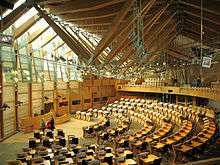
Local government
Following local government reorganisation in 1996, The City of Edinburgh Council constitutes one of the 32 council areas of Scotland.[174] Like all other local authorities of Scotland, the council has powers over most matters of local administration such as housing, planning, local transport, parks, economic development and regeneration.[175] The council comprises 58 elected councillors, returned from 17 multi-member electoral wards in the city.[176] Following the 2007 Scottish Local Elections the incumbent Labour Party lost majority control of the council after 23 years to a Liberal Democrat/SNP coalition.[177] The City of Edinburgh Council election, 2012 saw a Scottish Labour/SNP coalition. The City of Edinburgh Council election, 2017, saw a continuation of this administration, but with the SNP as the largest party.
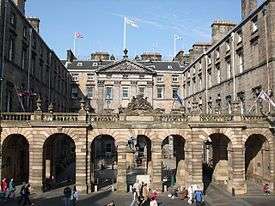
The city's coat of arms was registered by the Lord Lyon King of Arms in 1732.[178]
Scottish Parliament
Edinburgh, like all of Scotland, is represented in the Scottish Parliament. For electoral purposes, the city is divided into six constituencies which, along with 3 seats outside of the city, form part of the Lothian region.[179] Each constituency elects one Member of the Scottish Parliament (MSP) by the first past the post system of election, and the region elects seven additional MSPs to produce a result based on a form of proportional representation.[179]
As of the 2016 election, the Scottish National Party have three MSPs: Ash Denham for Edinburgh Eastern, Ben Macpherson for Edinburgh Northern and Leith and Gordon MacDonald for Edinburgh Pentlands constituencies. Alex Cole-Hamilton of the Scottish Liberal Democrats represents Edinburgh Western, Daniel Johnson of the Scottish Labour Party represents Edinburgh Southern constituency, and Scottish Conservative leader Ruth Davidson currently represents the Edinburgh Central constituency.
UK Parliament
Edinburgh is also represented in the House of Commons of the United Kingdom by five Members of Parliament. The city is divided into Edinburgh North and Leith, Edinburgh East, Edinburgh South, Edinburgh South West, and Edinburgh West,[180] each constituency electing one member by the first past the post system. Edinburgh is currently represented by three MPs affiliated with the Scottish National Party, one Liberal Democrat MP in Edinburgh West and one Labour MP in Edinburgh South.
Transport
%2C_24_June_2014.jpg)
Edinburgh Airport is Scotland's busiest and biggest airport and the principal international gateway to the capital, handling over 12 million passengers in 2016.[181] In anticipation of rising passenger numbers, the former operator of the airport BAA outlined a draft masterplan in 2011 to provide for the expansion of the airfield and the terminal building. In June 2012, Global Infrastructure Partners purchased the airport for £807 million.[182] The possibility of building a second runway to cope with an increased number of aircraft movements has also been mooted.[183]
Travel in Edinburgh is undertaken predominantly by bus. Lothian Buses operate the majority of city bus services within the city and to surrounding suburbs, with the most routes running via Princes Street. Services further afield operate from the Edinburgh Bus Station off St Andrew Square and Waterloo Place and are operated mainly by Stagecoach East Scotland, Scottish Citylink, National Express Coaches & West Coast Motors.
Lothian Buses, as the successor company to the Edinburgh Corporation Transport Department, also operates all of the city's branded public tour buses, night bus service and airport bus link. [184] In 2010, Lothian Buses recorded 109 million passenger journeys – a 1.9% rise on the previous year.[185]
Edinburgh Waverley is the second-busiest railway station in Scotland, with only Glasgow Central handling more passengers. On the evidence of passenger entries and exits between April 2015 and March 2016, Edinburgh Waverley is the fifth-busiest station outside London; it is also the UK's second biggest station in terms of the number of platforms and area size.[186] Waverley is the terminus for most trains arriving from London King's Cross and the departure point for many rail services within Scotland operated by Abellio ScotRail.
To the west of the city centre lies Haymarket Station which is an important commuter stop. Opened in 2003, Edinburgh Park station serves the Gyle business park in the west of the city and the nearby Gogarburn headquarters of the Royal Bank of Scotland. The Edinburgh Crossrail route connects Edinburgh Park with Haymarket, Edinburgh Waverley and the suburban stations of Brunstane and Newcraighall in the east of the city.[187] There are also commuter lines to South Gyle and Dalmeny, the latter serving South Queensferry by the Forth Bridges, and to Wester Hailes and Curriehill in the south west of the city.
To tackle traffic congestion, Edinburgh is now served by six park and ride sites on the periphery of the city at Sheriffhall (in Midlothian), Ingliston, Riccarton, Inverkeithing (in Fife), Newcraighall and Straiton (in Midlothian). A referendum of Edinburgh residents in February 2005 rejected a proposal to introduce congestion charging in the city. [188]
Edinburgh Trams became operational on 31 May 2014. The city had been without a tram system since Edinburgh Corporation Tramways ceased on 16 November 1956.[189] Following parliamentary approval in 2007, construction began in early 2008. The first stage of the project was expected to be completed by July 2011[190] but, following delays caused by extra utility work and a long-running contractual dispute between the Council and the main contractor, Bilfinger SE, the project was rescheduled.[191][192][193] The cost of the project rose from the original projection of £545 million to £750 million in mid-2011[194] and some suggest it could eventually exceed £1 billion.[195] The completed line is 8.7 miles (14.0 km) in length, running from Edinburgh Airport, west of the city, to its current terminus at York Place in the city centre's East End. It was originally planned to continue down Leith Walk to Ocean Terminal and where it would terminate at Newhaven.
Should the original plan be taken to completion, trams will also run from Haymarket through Ravelston and Craigleith to Granton Square on the Waterfront Edinburgh.[196] Long-term proposals envisage a line running west from the airport to Ratho and Newbridge and another connecting Granton Square to Newhaven via Lower Granton Road, thus completing the Line 1 (North Edinburgh) loop.[197] A further line serving the south of the city has also been suggested.
Lothian Buses and Edinburgh Trams are both owned and operated by Transport for Edinburgh.
Education
There are four universities in Edinburgh (including Queen Margaret University which lies just outwith the city boundary) with students making up around one-fifth of the population.[198] Established by Royal Charter in 1583, the University of Edinburgh is one of Scotland's ancient universities and is the fourth oldest in the country after St Andrews, Glasgow and Aberdeen.[199] Originally centred on Old College the university expanded to premises on the Mound, the Royal Mile and George Square.[199] Today, the King's Buildings in the south of the city contain most of the schools within the College of Science and Engineering. In 2002, the medical school moved to purpose built accommodation adjacent to the new Royal Infirmary of Edinburgh at Little France. The University is placed 18th in the QS World University Rankings for 2019.[12]
Heriot-Watt University and Napier Technical College were established in the 1960s.[199] Heriot-Watt began as the world's first Mechanics' Institute, tracing its origins to 1821 when it opened as a school for the technical education of the working classes.[200] The former Napier College was renamed Napier Polytechnic in 1986 and gained university status in 1992.[201] Edinburgh Napier University has campuses in the south and west of the city, including the former Merchiston Tower and Craiglockhart Hydropathic.[201] It is home to the Screen Academy Scotland.
Queen Margaret University was located in Edinburgh before it moved to a new campus near Musselburgh in 2008. Until 2012 further education colleges in the city included Jewel and Esk College (incorporating Leith Nautical College founded in 1903), Telford College, opened in 1968, and Stevenson College, opened in 1970. These have now been amalgamated to form Edinburgh College. Scotland's Rural College also has a campus in south Edinburgh. Other institutions include the Royal College of Surgeons of Edinburgh and the Royal College of Physicians of Edinburgh which were established by Royal Charter in 1506 and 1681 respectively. The Trustees Drawing Academy of Edinburgh, founded in 1760, became the Edinburgh College of Art in 1907.[202]
There are 18 nursery, 94 primary and 23 secondary schools administered by the City of Edinburgh Council.[203] Edinburgh is home to The Royal High School, one of the oldest schools in the country and the world. The city also has several independent, fee-paying schools including Edinburgh Academy, Fettes College, George Heriot's School, George Watson's College, Merchiston Castle School, Stewart's Melville College and The Mary Erskine School. In 2009, the proportion of pupils attending independent schools was 24.2%, far above the Scottish national average of just over 7% and higher than in any other region of Scotland.[204] In August 2013, the City of Edinburgh Council opened the city's first stand-alone Gaelic primary school, Bun-sgoil Taobh na Pàirce.[205]
Healthcare
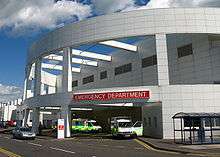
The main NHS Lothian hospitals serving the Edinburgh area are the Royal Infirmary of Edinburgh, which includes the University of Edinburgh Medical School, and the Western General Hospital,[206] which has a large cancer treatment centre and nurse-led Minor Injuries Clinic.[207] The Royal Edinburgh Hospital in Morningside specialises in mental health. The Royal Hospital for Sick Children, popularly referred to as 'the Sick Kids', is a specialist paediatrics hospital.
There are two private hospitals: Murrayfield Hospital in the west of the city and Shawfair Hospital in the south. Both are owned by Spire Healthcare.[206]
Sport
Football
Men's
Edinburgh has three football clubs that play in the Scottish Professional Football League (SPFL): Heart of Midlothian, founded in 1874, Hibernian, founded in 1875 and Edinburgh City, founded in 1966.
Heart of Midlothian and Hibernian are known locally as "Hearts" and "Hibs" respectively, both play in the Scottish Premiership.[208] They are the oldest city rivals in Scotland and the Edinburgh derby is one of the oldest derby matches in world football. Both clubs have won the Scottish league championship four times. Hearts have won the Scottish Cup eight times and the Scottish League Cup four times. Hibs have won the Scottish Cup and the Scottish League Cup three times each. Edinburgh City were promoted to the SPFL Scottish League Two in the 2015–16 season, becoming the first club to win promotion to the Scottish Professional Football League via the pyramid system.
Edinburgh was also home to three other former Scottish Football League clubs: Leith Athletic, Meadowbank Thistle and St Bernard's. Meadowbank Thistle played at Meadowbank Stadium until 1995, when the club moved to Livingston and became Livingston F.C. The Scottish national team has very occasionally played at Easter Road and Tynecastle, although its normal home stadium is Hampden Park in Glasgow. St Bernard's' New Logie Green was used to host the 1896 Scottish Cup Final, the only time the match has been played outside Glasgow.[209]
The city also plays host to Lowland Football League clubs Civil Service Strollers, Edinburgh University and Spartans, as well as junior clubs Edinburgh United and Craigroyston, and East of Scotland League clubs Heriot-Watt University, Leith Athletic, Lothian Thistle Hutchison Vale and Tynecastle.
Women's
In women's football, Hibs and Spartans play in the SWPL 1. Hearts and Edinburgh University Hutchison Vale (EUHV) play in the SWPL 2.[210][211]
Rugby
The Scotland national rugby union team and the professional Edinburgh Rugby team play at Murrayfield Stadium, which is owned by the Scottish Rugby Union and also used for other events, including music concerts. It is the largest capacity stadium in Scotland, seating 67,144 spectators.[212] Edinburgh is also home to RBS Premier One rugby teams Boroughmuir RFC, Heriot's Rugby Club, the Edinburgh Academicals, Currie RFC and Watsonians RFC.[213]
Rugby league is represented by the Edinburgh Eagles who play in the Rugby League Conference Scotland Division. Murrayfield Stadium has hosted the Magic Weekend where all Super League matches are played in the stadium over one weekend.
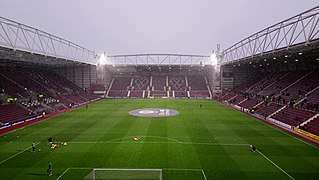
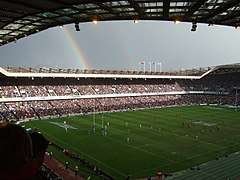
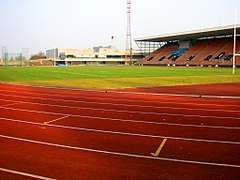
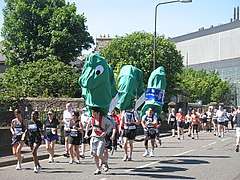 Edinburgh Marathon
Edinburgh Marathon Murrayfield Ice Rink
Murrayfield Ice Rink
Other sports
The Scottish cricket team, which represents Scotland internationally, play their home matches at the Grange cricket club.[214]
The Murrayfield Racers are the latest of a succession of ice hockey clubs in the Scottish capital. Previously Edinburgh was represented by the Edinburgh Capitals (who folded in 2018), the original Murrayfield Racers (who folded in 1996) and the Edinburgh Racers. The club play their home games at the Murrayfield Ice Rink and have competed in the eleven-team professional Scottish National League (SNL) since the 2018–19 season.[215]
Next door to Murrayfield Ice Rink is a 7-sheeter dedicated curling facility where curling is played from October to March each season.
Caledonia Pride are the only women's professional basketball team in Scotland. Established in 2016, the team compete in the UK wide Women's British Basketball League and play their home matches at the Oriam National Performance Centre. Edinburgh also has several men's basketball teams within the Scottish National League. Boroughmuir Blaze, City of Edinburgh Kings and Edinburgh University all compete in Division 1 of the National League, and Edinburgh Lions and Pleasance B.C. compete in Division 2. Boroughmuir won the league in 2016, and won the playoffs in the same year, beating the University in the final.
The Edinburgh Diamond Devils is a baseball club which won its first Scottish Championship in 1991 as the "Reivers." 1992 saw the team repeat the achievement, becoming the first team to do so in league history. The same year saw the start of their first youth team, the Blue Jays. The club adopted its present name in 1999.[216]
Edinburgh has also hosted national and international sports events including the World Student Games, the 1970 British Commonwealth Games,[217] the 1986 Commonwealth Games[217] and the inaugural 2000 Commonwealth Youth Games.[218] For the 1970 Games the city built Olympic standard venues and facilities including Meadowbank Stadium and the Royal Commonwealth Pool. The Pool underwent refurbishment in 2012 and is due to host the Diving competition in the 2014 Commonwealth Games which will be held in Glasgow.[219]
In American football, the Scottish Claymores played WLAF/NFL Europe games at Murrayfield, including their World Bowl 96 victory. From 1995 to 1997 they played all their games there, from 1998 to 2000 they split their home matches between Murrayfield and Glasgow's Hampden Park, then moved to Glasgow full-time, with one final Murrayfield appearance in 2002.[220] The city's most successful non-professional team are the Edinburgh Wolves who play at Meadowbank Stadium.[221]
The Edinburgh Marathon has been held annually in the city since 2003 with more than 16,000 runners taking part on each occasion.[222] Its organisers have called it "the fastest marathon in the UK" due to the elevation drop of 40 metres (130 ft).[223] The city also organises a half-marathon, as well as 10 km (6.2 miles) and 5 km (3.1 mi) races, including a 5 km (3 miles) race on 1 January each year.
Edinburgh has a speedway team, the Edinburgh Monarchs, which, since the loss of its stadium in the city, has raced at the Lothian Arena in Armadale, West Lothian. The Monarchs have won the Premier League championship five times in their history, in 2003[224] and again in 2008,[225] 2010, 2014 and 2015.
Notable residents

Edinburgh has a long literary tradition, which became especially evident during the Scottish Enlightenment. This heritage and the city's lively literary life in the present led to it being declared the first UNESCO City of Literature in 2004.[226][227] Famous authors who have lived in Edinburgh include the economist Adam Smith, born in Kirkcaldy and author of The Wealth of Nations, [228] James Boswell, biographer of Samuel Johnson; Sir Walter Scott, creator of the historical novel and author of famous titles such as Rob Roy, Ivanhoe, and Heart of Midlothian; James Hogg, author of The Private Memoirs and Confessions of a Justified Sinner; Robert Louis Stevenson, creator of Treasure Island, Kidnapped, and The Strange Case of Dr Jekyll and Mr Hyde; Sir Arthur Conan Doyle, the creator of Sherlock Holmes; Muriel Spark, author of The Prime of Miss Jean Brodie; Irvine Welsh, author of Trainspotting, whose novels are mostly set in the city and often written in colloquial Scots; [229] Ian Rankin, author of the Inspector Rebus series of crime thrillers, Alexander McCall Smith, author of the No. 1 Ladies' Detective Agency series,[230] and J. K. Rowling, creator of Harry Potter, who began her first book in an Edinburgh coffee shop.[231]
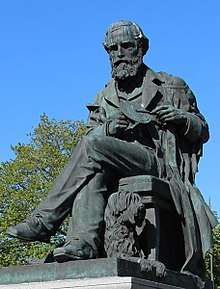
Scotland has a rich history of science and engineering, with Edinburgh producing a number of famous names. John Napier, inventor of logarithms, was born in Merchiston Tower and lived and died in the city.[232] His house now forms part of the original campus of Napier University which was named in his honour. He lies buried under St. Cuthbert's Church. James Clerk Maxwell, founder of the modern theory of electromagnetism, was born at 14 India Street (now the home of the James Clerk Maxwell Foundation) and educated at the Edinburgh Academy and the University of Edinburgh,[228] as was the engineer and telephone pioneer Alexander Graham Bell.[228] James Braidwood, who organised Britain's first municipal fire brigade, was also born in the city and began his career there.
Other names connected with the city include Max Born, physicist and Nobel laureate;[233] Charles Darwin, the biologist who propounded the theory of natural selection;[228] David Hume, philosopher, economist and historian;[228] James Hutton, regarded as the "Father of Geology";[228] Joseph Black, the chemist and one of the founders of thermodynamics;[228] pioneering medical researchers Joseph Lister and James Young Simpson;[228] chemist and discoverer of the element nitrogen Daniel Rutherford; Colin Maclaurin, mathematician and developer of the Maclaurin series,[234] and Ian Wilmut, the geneticist involved in the cloning of Dolly the sheep just outside Edinburgh.[228] The stuffed carcass of Dolly the sheep is now on display in the National Museum of Scotland.[235] The latest in a long line of science celebrities associated with the city is theoretical physicist and Nobel Prizewinner Professor Emeritus Peter Higgs, born in Newcastle but resident in Edinburgh for most of his academic career, after whom the Higgs boson particle has been named.[236]
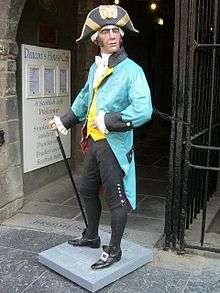
Edinburgh has been the birthplace of actors like Alastair Sim and Sir Sean Connery, famed as the first cinematic James Bond,[237] the comedian and actor Ronnie Corbett, best known as one of The Two Ronnies,[238] and the impressionist Rory Bremner. Famous artists from the city include the portrait painters Sir Henry Raeburn, Sir David Wilkie and Allan Ramsay.
The city has produced or been home to some very successful musicians in recent decades, particularly Ian Anderson, front man of the band Jethro Tull, The Incredible String Band, the folk duo The Corries, Wattie Buchan, lead singer and founding member of punk band The Exploited, Shirley Manson, lead singer of the band Garbage, the Bay City Rollers, The Proclaimers, Boards of Canada and Idlewild.
Edinburgh is the birthplace of former British Prime Minister Tony Blair who attended the city's Fettes College.[239]
Notorious criminals from Edinburgh's past include Deacon Brodie, head of a trades guild and Edinburgh city councillor by day but a burglar by night, who is said to have been the inspiration for Robert Louis Stevenson's story, the Strange Case of Dr Jekyll and Mr Hyde,[240] and murderers Burke and Hare who delivered fresh corpses for dissection to the famous anatomist Robert Knox.[241]
Another well-known Edinburgh resident was Greyfriars Bobby. The small Skye Terrier reputedly kept vigil over his dead master's grave in Greyfriars Kirkyard for 14 years in the 1860s and 1870s, giving rise to a story of canine devotion which plays a part in attracting visitors to the city.[242]
International relations
Twin towns and sister cities
The City of Edinburgh has entered into 14 international twinning arrangements since 1954.[243] Most of the arrangements are styled as 'Twin Cities' but the agreement with Kraków is designated as a 'Partner City',[243] and the agreement with Kyoto Prefecture is officially styled as a 'Friendship Link', reflecting its status as the only region to be twinned with Edinburgh.[243]
| City | Since |
|---|---|
| 1954 | |
| 1958[244][245] | |
| 1964 | |
| 1974 | |
| 1977[246] | |
| 1977 | |
| 1985 | |
| 1985[247] | |
| 1989 | |
| 1991[248] | |
| 1994 | |
| 1994 | |
| 1995[249] | |
| 1995[250][251] |
For a list of consulates in Edinburgh see List of diplomatic missions in Scotland.
See also
References
- ↑ "Edinburgh, United Kingdom Forecast : Weather Underground (weather and elevation at Queensferry Road, Edinburgh)". The Weather Underground, Inc. Retrieved 29 September 2013.
- 1 2 3 "Mid-2012 Population Estimates for Settlements and Localities in Scotland". nationalrecordsofscotland.gov.uk. Retrieved 25 November 2015.
- 1 2 3 4 5 6 7 "Mid-Year Population Estimates Scotland, Mid-2017 Population estimates by sex, age and area" (PDF). Nrscotland.gov.uk. Retrieved 12 April 2018.
- 1 2 3 4 "Edinburgh and South East Scotland City Region". Retrieved 25 November 2015.
- 1 2 "Global city GDP 2014". Brookings Institution. Archived from the original on 4 June 2013. Retrieved 18 November 2014.
- ↑ "Definition of Edinburgh in Oxford dictionary. Meaning, pronunciation and origin of the word". Oxford Dictionaries. Oxford University Press. 2013. Retrieved 12 January 2014.
- ↑ "edinburgh - Definition, pictures, pronunciation and usage notes - Oxford Advanced Learner's Dictionary at OxfordLearnersDictionaries.com". www.oxfordlearnersdictionaries.com.
- ↑ "the definition of Edinburgh". Dictionary.com.
- ↑ Invest in Edinburgh. "Financial Services". Retrieved 3 October 2017.
- ↑ "Edinburgh second in TripAdvisor UK tourism poll". BBC News Online. 3 May 2011. Retrieved 16 March 2013.
- ↑ The City of Edinburgh Council. "City Region Deal secured". Retrieved 3 October 2017.
- 1 2 "UNIVERSITY OF EDINBURGH RANKINGS". Quacquarelli Symonds. Retrieved 4 October 2018.
- 1 2 "Edinburgh-World Heritage Site". VisitScotland. Archived from the original on 22 February 2013. Retrieved 10 February 2013.
- ↑ Williams, Ifor (1972). The Beginnings of Welsh Poetry: Studies. University of Wales Press. p. 47. ISBN 978-0-7083-0035-0.
- ↑ Chadwick, Nora K. (1968). The British Heroic Age: the Welsh and the Men of the North. University of Wales Press. p. 107. ISBN 978-0-7083-0465-5.
- ↑ Dumville, David (1994). "The eastern terminus of the Antonine Wall: 12th or 13th century evidence". Proceedings of the Society of Antiquaries of Scotland. 124: 293–98.
- ↑ Cessford, Craig (1994). "Gardens of the 'Gododdin'". Garden History. 22 (1): 114–15.
- ↑ Room, Adrian (2006). Placenames of the World. McFarland. pp. 118–119. ISBN 978-0-7864-2248-7. Retrieved 12 August 2011.
- ↑ Ramsay, Allan. The poems of Allan Ramsay. 1. p. 50.
- ↑ Carlyle, Thomas. Historical Sketches.…. pp. 304–305. Retrieved 2018-05-13.
- ↑ Scott, Walter. The Abbot. Retrieved 2018-05-13.
- ↑ Chambers, Robert. Traditions of Edinburgh. p. 168. Retrieved 2018-05-13.
- ↑ Stoppard, Tom. Jumpers, Grove Press, 1972, p. 69.
- ↑ Grässe, J. G. Th. (1909) [1861]. "A". Orbis latinus; oder, Verzeichnis der wichtigsten lateinischen orts- und ländernamen (in German) (2nd ed.). Berlin: Schmidt. OCLC 1301238 http://www.columbia.edu/acis/ets/Graesse/orblata.html
|url=missing title (help) – via Columbia University. - ↑ "Pharmaceutical Latin Abbreviations". Herbdatanz.com. Archived from the original on 2006-05-05. Retrieved 2009-07-08.
- ↑ The Cambridge Companion to Ben Jonson. Retrieved 17 April 2007.
- ↑ Marmion A Tale of Flodden Field by Walter Scott. Retrieved 17 April 2007.
- ↑ "Embro, Embro - the hidden history of Edinburgh in its music". Purr.demon.co.uk. Retrieved 2009-07-08.
- ↑ "Makars Literary Tour | Robert Garioch". Edinburghliterarypubtour.co.uk. Retrieved 2009-07-08.
- ↑ "Earliest evidence found of settlers in Scotland: hazelnuts and stone tools excavated near Edinburgh date to around 8500 BC". Archived from the original on 2 November 2013. Retrieved 31 October 2013.
- ↑ Coghill, Hamish (2008). Lost Edinburgh. Birlinn Ltd. pp. 1–2. ISBN 978-1-84158-747-9.
- ↑ Ritchie, J. N. G. and A. (1972). Edinburgh and South-East Scotland. Heinemann. p. 51. ISBN 978-0-435-32971-6.
- ↑ Fraser, James (2009). From Caledonia to Pictland: Scotland to 795. Edinburgh University Press. p. 171. ISBN 978-0-7486-1232-1. Retrieved 13 February 2013.
- ↑ Watson, William (1926). The Celtic Place Names of Scotland. p. 340. ISBN 978-1-906566-35-7.
- ↑ Lynch, Michael (2001). The Oxford Companion to Scottish History. Oxford University Press. p. 658. ISBN 978-0-19-923482-0.
- ↑ Daiches, David (1978). Edinburgh. Hamish Hamilton. p. 15. ISBN 978-0-241-89878-9.
- ↑ Barrow, Geoffrey (1999). The Charters of King David I: The Written Acts of David I King of Scots …. p. 63. ISBN 978-0851157313.
- ↑ Dickinson, W C (1961). Scotland, From The Earliest Times To 1603. Edinburgh: Thomas Nelson. p. 119.
- ↑ Dickinson, W C (1961). Scotland, From The Earliest Times To 1603. Edinburgh: Thomas Nelson. pp. 236–8.
- ↑ Donaldson, Gordon (1960). The Scottish Reformation. Cambridge University Press. p. 53. ISBN 978-0-521-08675-2.
- ↑ "Scottish Covenanter Memorials Association". covenanter.org. Archived from the original on 13 May 2013. Retrieved 10 February 2013.
- ↑ Donaldson, Gordon (1967). Scottish Kings. Batsford. p. 213.
- ↑ Newman, P R (1990). Companion to the English Civil Wars. Oxford: Facts on File Ltd. p. 13. ISBN 978-0-8160-2237-3.
- ↑ Stephen C. Manganiello (2004). The Concise Encyclopedia of the Revolutions and Wars of England, Scotland, and Ireland, 1639–1660. Scarecrow Press. p. 587. ISBN 978-0-8108-5100-9. Retrieved 11 February 2013.
- ↑ Chambers, Robert (1824). Notices of the most remarkable fires in Edinburgh, from 1385 to 1824. p. 11. Retrieved 17 February 2013.
- ↑ Wilson, Neil (2008). Edinburgh Encounter. p. 37. ISBN 978-1-74179-306-2.
- ↑ Scott, Paul (1979). 1707: the Union of Scotland and England. Chambers. pp. 51–54. ISBN 978-0-550-20265-9.
- ↑ Kelly (1998). The making of the United Kingdom and Black peoples of the Americas. Heinemann. p. 77. ISBN 978-0-435-30959-6. Archived from the original on 2 December 2013. Retrieved 23 January 2011.
- ↑ Defoe, Daniel (1978). A Tour Through The Whole Island of Britain. London: Penguin. p. 577"... I believe, this may be said with truth, that in no city in the world so many people live in so little room as at Edinburgh."
- ↑ Topham, E. (1971). Letters from Edinburgh 1774–1775. Edinburgh: James Thin. p. 27. ISBN 978-1-236-68255-0. Retrieved 18 March 2013"... I make no manner of doubt but that the High Street in Edinburgh is inhabited by a greater number of persons than any street in Europe."
- ↑ Graham, H. G. (1906). The Social Life of Scotland in the Eighteenth Century. London: Adam and Charles Black. p. 85. Retrieved 18 March 2013.
- ↑ Lenman, Bruce (1986). The Jacobite Cause. Richard Drew Publishing. p. 104. ISBN 978-0-86267-159-4. Retrieved 18 March 2013.
- ↑ Ferguson, W (1987). Scotland, 1689 to the Present. Edinburgh: Mercat Press. p. 154. ISBN 978-0-901824-86-8--These clans were mainly Episcopalian (70 per cent) and Roman Catholic (30 per cent), p.151
- ↑ Keay, K; Keay, J (1994). Collins Encyclopaedia of Scotland. HarperCollins. p. 285. ISBN 978-0-00-255082-6.
- 1 2 "History of Princes Street". princes-street.com. Retrieved 14 February 2013.
- ↑ William Robertson (1997). William Robertson and the expansion of empire. Cambridge University Press. p. 2. ISBN 9780521570831. Retrieved 18 February 2011.
- ↑ Blackwood's Edinburgh magazine. 11. 1822. p. 323. Retrieved 18 January 2011.
- ↑ "Letter from Matthew Bramble on August 8". The Expedition of Humphry Clinker. Project Gutenberg. 2000. Retrieved 13 October 2013.
- ↑ "The manuscripts, Letter from Andrew Millar to Robert Wodrow, 15 July, 1725. Andrew Millar Project. University of Edinburgh". www.millar-project.ed.ac.uk. Retrieved 3 June 2016.
- ↑ Youngson, A J (1988). The Making of Classical Edinburgh. Edinburgh University Press. p. 256. ISBN 978-0-85224-576-7.
- ↑ Pryde, George Smith (1962). Scotland from 1603 to the present day. Nelson. p. 141.
Population figures for 1801 – Glasgow 77,385; Edinburgh 82,560; for 1821 – Glasgow 147,043; Edinburgh 138,325
- ↑ Hogg, A (1973). "Topic 3:Problem Areas". Scotland: The Rise of Cities 1694–1905. London: Evans Brothers Ltd. ISBN 978-0237286569.
- ↑ McWilliam, C (1975). Scottish Townscape. London: Collins. p. 196. ISBN 978-0-00-216743-7.
- ↑ McWilliam, C (1975). Scottish Townscape. London: Collins. p. 197. ISBN 978-0-00-216743-7.
- ↑ Coghill, H (2008). Lost Edinburgh. Edinburgh: Birlinn Ltd. pp. 219–220. ISBN 978-1-84158-747-9.
- ↑ "Financial services". www.investinedinburgh.com. Edinburgh City Council. Retrieved 7 July 2017.
- ↑ Keay, John (1994). Collins Encyclopaedia of Scotland. 1994. p. 286. ISBN 978-0-00-255082-6.
- 1 2 Rae, William (1994). Edinburgh, Scotland's Capital City. Mainstream. p. 164. ISBN 978-1-85158-605-9.
- ↑ "Scottish Executive renames itself". Retrieved 24 August 2014.
- ↑ "Scotland Act 1998". 19 November 1998. Retrieved 15 March 2013.
- ↑ Geographia Atlas of the World (Map). London: Geographia Ltd. 1984. p. 99. ISBN 0-09-202840-3.
- ↑ "Seven Hills of Edinburgh". VisitScotland. Retrieved 28 February 2013.
- ↑ "Voltaire said: Athens of the North". Scotland.org. September 2003. Retrieved 28 March 2013.
- 1 2 3 4 5 6 7 8 Edwards, Brian; Jenkins, Paul (2005). Edinburgh: The Making of a Capital City. Edinburgh University Press. pp. 64–65. ISBN 978-0-7486-1868-2.
- ↑ Stuart Piggott (1982). Scotland before History. Edinburgh University Press. ISBN 978-0-85224-470-8.
- ↑ "Sill". landforms.eu. Retrieved 29 March 2013.
- ↑ "Overview of the Water of Leith". Gazetteer for Scotland, Institute of Geography, University of Edinburgh. Retrieved 19 April 2009.
- ↑ "The Water of Leith Walkway". Water of Leith Conservation Trust. Retrieved 19 April 2009.
- 1 2 3 4 5 "Review of Green Belt policy in Scotland – Edinburgh and Midlothian". Scottish Government. 11 August 2004. Retrieved 10 April 2009.
- ↑ "Edinburgh Areas". edinburghguide.com. Retrieved 9 February 2013.
- ↑ "Edinburgh area guide". timeout.com. Retrieved 9 February 2013.
- ↑ "Old and New Towns of Edinburgh". UNESCO. Retrieved 9 February 2013.
- ↑ Chambers, Robert (1824). Notices of the most remarkable fires in Edinburgh: from 1385 to 1824 …. Retrieved 9 January 2012.
- ↑ Cruft, Kitty. "James Craig 1739–1795: Correction of his Date of Birth". Book of the Old Edinburgh Club. New Series Vol. 5: 103–5.
- ↑ "Scottish Architects Homecoming" (PDF). Historic Scotland. Archived from the original (PDF) on 19 November 2011. Retrieved 18 January 2011.
- ↑ "Bute House". edinburghguide.com. Retrieved 9 February 2013.
- ↑ "From monks on strike to dove's dung". scotsman.com. Retrieved 9 February 2013.
- ↑ "The Prime of Miss Jean Brodie". geraldinemcewan.com. Retrieved 9 February 2013.
- ↑ "Inspector Rebus Novels". ianrankin.net. Archived from the original on 3 March 2013. Retrieved 9 February 2013.
- ↑ Edinburgh Corporation (1929). Edinburgh 1329–1929, Sexcentenary of Bruce Charter. Edinburgh: Oliver And Boyd. p. xxvii.
- ↑ "The Story of Leith XXXIII. How Leith was Governed".
- ↑ "Untitled" (PDF). Economic and Social Data Service. Retrieved 14 October 2013--note incorrect date given for Henry Robb shipyard closure
- 1 2 3 4 5 6 7 "Regional Climate – Eastern Scotland". Met Office. Retrieved 19 April 2009.
- ↑ "December 2010 minimum". Archived from the original on 12 January 2012. Retrieved 31 October 2011.
- ↑ "Climatology details". eca.knmi.nl. Retrieved 12 August 2017.
- ↑ "Edinburgh Gogarbank Climate Averages 1981–2010". Met Office. Retrieved 11 August 2015.
- ↑ "Mean Royal Botanic Gardens Edinburgh Climatic Averages 1981–2010". Met Office. Retrieved 22 December 2012.
- ↑ "Edinburgh Gogarbank Climatic Averages 1981–2010". Met Office. Retrieved 11 August 2015.
- ↑ "Edinburgh Comparisons – Population and Age Structure" (PDF). City of Edinburgh Council. Archived from the original (PDF) on 5 February 2009. Retrieved 31 January 2009.
- ↑ "Comparative Population Profile – Edinburgh Locality". Scotland's Census Results Online (SCROL). Archived from the original on 4 February 2012. Retrieved 31 January 2009.
- 1 2 3 "Archived copy". Archived from the original on 2 January 2014. Retrieved 29 December 2013.
- ↑ "Edinburgh ScoP through timePopulation Table View". www.visionofbritain.org.uk.
- ↑ Lynch, Michael (2001). The Oxford Companion to Scottish History. OUP Oxford. p. 219. ISBN 978-0-19-969305-4.
- 1 2 3 Edwards, Brian; Jenkins, Paul (2005). Edinburgh: The Making of a Capital City. p. 9. ISBN 978-0-7486-1868-2.
- ↑ Gilbert (ed.), W M (1967) [1901]. Edinburgh in the Nineteenth Century. Edinburgh: J & R Allan Ltd. pp. 95, 120, 140.
- 1 2 Edwards, Brian; Jenkins, Paul (2005). Edinburgh: The Making of a Capital City. p. 46. ISBN 978-0-7486-1868-2.
- ↑ "Edinburgh Comparisons – Dwellings" (PDF). City of Edinburgh Council. Archived from the original (PDF) on 18 March 2009. Retrieved 8 February 2009.
- ↑ "A BRIEF HISTORY OF EDINBURGH, SCOTLAND". localhistories.org. Retrieved 9 February 2013.
- ↑ Church of Scotland Yearbook, 2010–2011 edition. St Andrew Press. 2011. ISBN 978-0-86153-610-8.
- ↑ "St Giles' Cathedral Edinburgh -Building and History". Archived from the original on 21 July 2012. Retrieved 22 March 2013.
- ↑ "Saint Giles Cathedral". edinburghnotes.com. Archived from the original on 28 September 2012. Retrieved 14 February 2013.
- ↑ "St Cuthbert's History". The Parish Church of St Cuthbert. Retrieved 12 February 2013.
- ↑ "St Cuthbert's History". The Parish Church of St Cuthbert. Retrieved 12 February 2013.
- ↑ "The Church of Scotland". Church of Scotland. Retrieved 12 February 2013.
- ↑ "General Assembly". Church of Scotland. Retrieved 12 February 2013.
- ↑ "Parish List". Roman Catholic Archdiocese of St Andrews and Edinburgh. Retrieved 12 February 2013.
- ↑ "St Bennet's Chapel, Edinburgh". Scotland's Churches Trust. Archived from the original on 6 October 2014. Retrieved 29 September 2014.
- ↑ "Contact". Archdiocese-edinburgh.com. Retrieved 9 February 2013.
- ↑ "Who we are". Diocese of Edinburgh. Archived from the original on 22 July 2012. Retrieved 12 February 2013.
- ↑ "St Mary's Cathedral, Edinburgh". Diocese of Edinburgh. Archived from the original on 6 October 2014. Retrieved 12 February 2013.
- ↑ "Independent Churches". scottishchristian.com. Retrieved 12 February 2013.
- ↑ "Edinburgh Christadelphian Church". searchforhope.org. Retrieved 12 February 2013.
- ↑ "King Fahd Mosque and Islamic Centre". Gazetteer for Scotland. Retrieved 13 February 2013.
- ↑ "Mosques in Edinburgh around edinburgh area". Mosquedirectory.co.uk. Retrieved 24 August 2011.
- ↑ "Edinburgh Qiadat Holds Holy Qur'an Exhibition". khuddam.org. Archived from the original on 21 October 2014. Retrieved 30 March 2014.
- ↑ "Edinburgh Jewish History". Edinburgh Hebrew Congregation. Retrieved 10 February 2015.
- ↑ "Brahma Kumaris Official Website – Around the UK". Bkwsu.org. Archived from the original on 2 March 2013. Retrieved 13 February 2013.
- ↑ "Edinburgh Buddhist Centre · Buddhism and Meditation". Edinburghbuddhistcentre.org.uk. 18 July 2013. Retrieved 21 July 2014.
- ↑ "Edinburgh Zen Buddhism". Portobellobuddhist.org.uk. Retrieved 24 August 2011.
- ↑ "Local Groups – Edinburgh Buddhist sangha, meditation". Mysangha.org.uk. Retrieved 13 February 2013.
- ↑ "Overview (Edinburgh Baha'i Community UK)". Edin-bahai.org.uk. Retrieved 24 August 2011.
- ↑ "Theosophical Society of Scotland Homepage". Theosophical Society of Scotland. Archived from the original on 20 December 2012. Retrieved 13 February 2013.
- ↑ "About Us". Edinburgh Interfaith Association. 2017. Retrieved 21 December 2017.
- ↑ "Working in Edinburgh". Archived from the original on 24 February 2013. Retrieved 24 March 2013.
- ↑ "The UK Competitive Index 2010". Centre for International Competitiveness. Retrieved 10 May 2010.
- ↑ "Edinburgh by Numbers 2012/2013". Edinburgh Inspiring Capital. Archived from the original on 13 November 2013. Retrieved 14 January 2014.
- 1 2 "Edinburgh by Numbers". Archived from the original (PDF) on 11 June 2014. Retrieved 16 June 2014.
- 1 2 "Edinburgh Economy Watch April 2010". City of Edinburgh Council. Archived from the original on 13 February 2010. Retrieved 10 May 2010.
- ↑ "Edinburgh's financial services sector". Edinburgh Brand. Archived from the original on 16 November 2010. Retrieved 11 May 2010.
- ↑ "Sainsburys-Bank-hires-500-staff-in-travel-money-push". The Telegraph. Edinburgh. 24 June 2014. Retrieved 24 June 2014.
- ↑ "Tesco creates 200 banking jobs in Edinburgh". The Scotsman. Edinburgh. 2 March 2009. Retrieved 9 February 2013.
- ↑ "Virgin Money provides jobs boost for city". The Scotsman. Edinburgh. 13 January 2010. Retrieved 10 May 2010.
- ↑ "2004 Festival Economic Impact Study results". Edinburgh Festival Fringe. 14 October 2005. Archived from the original on 27 September 2007. Retrieved 23 March 2007.
- ↑ "The Edinburgh Festival & Fringe Festival". timeout.com. Archived from the original on 20 January 2013. Retrieved 10 February 2013.
- ↑ Pamment, Charles (28 July 2006). "The arts go on show in Edinburgh". BBC News. Retrieved 12 January 2011.
- ↑ "'New world' theme for Edinburgh International Festival". BBC News. 17 March 2010. Retrieved 12 January 2011.
- ↑ "Record numbers at Edinburgh's festivals". BBC News. 28 August 2017. Retrieved 16 March 2018.
- ↑ "Stage set for Edinburgh Fringe success". BBC News Edinburgh, East, & Fife. August 2010. Retrieved 12 January 2011.
- ↑ "Kane wins Edinburgh comedy award". BBC News Scotland. August 2010. Retrieved 12 January 2011.
- ↑ "Edinburgh International Film Festival". Edinburgh International Film Festival. Retrieved 7 April 2014.
- ↑ "Scottish Science Festivals". The Scottish Government. Retrieved 12 January 2011.
- 1 2 "Hogmanay-the Scottish New Year". BBC. 10 May 2006. Retrieved 13 January 2011.
- ↑ Jamieson, Alastair (19 February 2004). "Pagan fire festival reignites with a fee". The Scotsman. Edinburgh. Retrieved 13 January 2011.
- ↑ "Festival is flaming marvellous". The Scotsman. 6 October 2008. Retrieved 12 February 2013.
- ↑ "Theatres in Edinburgh and the Lothians". VisitScotland. Archived from the original on 26 January 2013. Retrieved 9 February 2013.
- ↑ "Heritage & Culture". The Scotsman. UK. 27 February 2010. Retrieved 13 January 2011.
- ↑ "About the Orchestra". Scottish Chamber Orchestra. Archived from the original on 10 January 2013. Retrieved 9 February 2013.
- ↑ "Edinburgh venues". Edinburgh Guide.com. Retrieved 13 January 2011.
- ↑ "Bristol is UK's 'most musical city'". The Daily Telegraph. London. 12 March 2010.
- ↑ "John McLeod: Composer". Johnmcleod.uk.com. Retrieved 8 July 2009.
- ↑ "Award-Winning Video Game Developer Based in Edinburgh, Scotland". Rockstar North. Retrieved 9 February 2013.
- ↑ "Contact us". The Scotsman. Retrieved 9 February 2013.
- ↑ "Radio Forth". radioforth.com. Retrieved 9 February 2013.
- ↑ Tulloch, Pamela (5 January 2015). "STV Edinburgh launches with The Fountainbridge Show on January 12". STV. Retrieved 5 January 2015.
- ↑ "TV digital switchover gets under way in east". BBC News. 1 June 2011. Retrieved 9 February 2013.
- ↑ Kirsty Scott (12 October 2011). "10 of the best museums and galleries in Edinburgh". The Guardian. London. Retrieved 10 February 2013.
- ↑ "Zoo Beginnings". About the Zoo. Edinburgh Zoo. Archived from the original on 20 January 2013. Retrieved 10 February 2013.
- ↑ "Portrait of the Nation". National Galleries of Scotland. Retrieved 13 January 2011.
- ↑ "Simon Schama's Power of Art". Retrieved 13 January 2011.
- ↑ "Trio grande". Heraldscotland. Retrieved 13 January 2011.
- 1 2 3 "Shopping – Edinburgh's Princes Street and other areas". edinburgh.org. Archived from the original on 6 February 2013. Retrieved 10 February 2013.
- ↑ "Retailers". stjamesshopping.com. Archived from the original on 21 June 2013. Retrieved 10 February 2013.
- ↑ "Retail locations in Edinburgh City Region". edinburgh-inspiringcapital.com. Archived from the original on 6 February 2012. Retrieved 10 February 2013.
- ↑ "Schedule 1 – New Local Government Areas – Local Government etc (Scotland) Act 1994". Office of Public Sector Information (OPSI). 3 November 1994. Retrieved 12 February 2013.
- ↑ "Chapter 6 – Functions – Local Government etc (Scotland) Act 1994". Office of Public Sector Information (OPSI). 3 November 1994. Retrieved 8 June 2008.
- ↑ "Councillors". City of Edinburgh Council. Retrieved 12 February 2013.
- ↑ "Nationalist negotiate coalition deals in some of Scotland's largest cities". CityMayors Politics. 4 June 2007. Retrieved 16 January 2011.
- ↑ Urquhart, R M (1973). Scottish Burgh and County Heraldry. London: Heraldry Today. p. 9. ISBN 978-0-900455-24-7.
- 1 2 "Scottish Parliament election results 2007". Elections Office – City of Edinburgh Council. 3 May 2007. Archived from the original on 8 May 2011. Retrieved 14 January 2009.
- ↑ "UK Parliament constituencies 2005 onwards". bcomm-scotland.independent.gov.uk. Archived from the original on 4 May 2013. Retrieved 12 February 2013.
- ↑ "Edinburgh and Glasgow airports record highest passenger numbers". BBC News. 11 January 2017. Retrieved 4 May 2017.
- ↑ "Scottish airport sold for £807m". 23 April 2012 – via www.bbc.co.uk.
- ↑ "Edinburgh Airport Masterplan July 2011" (PDF). edinburghairport.com. Archived from the original (PDF) on 15 February 2013. Retrieved 12 February 2013.
- ↑ "Our company". Lothian Buses. Retrieved 9 February 2012.
- ↑ "LOTHIAN BUSES plc CONSOLIDATED REPORTS AND ACCOUNTS" (PDF). Lothian Buses. Archived from the original (PDF) on 26 January 2013. Retrieved 9 February 2012.
- ↑ Pigott, Nick, ed. (June 2012). "Waterloo still London's busiest station". The Railway Magazine. Vol. 158 no. 1334. Horncastle, Lincs: Mortons Media Group. p. 6.
- ↑ "Edinburgh CrossRail project". Scottish Government. 4 December 2001. Retrieved 19 February 2013.
- ↑ "Edinburgh rejects congestion plan". BBC News. 22 February 2005. Retrieved 8 February 2013.
- ↑ Wiseman, Richard Joseph Stewart (2005). Edinburgh's Trams: The Last years. Stenlake Publishing. pp. 2–3. ISBN 978-1-84033-343-5.
- ↑ "Backing for capital tram system". BBC News. 25 October 2007. Retrieved 19 February 2013.
- ↑ "Train interchange delay threatens to push back tram project". The Scotsman. 18 June 2009. Retrieved 25 January 2010.
- ↑ "Tram testing set to increase". Edinburgh Trams. 17 February 2014. Retrieved 21 July 2014.
- ↑ "Edinburgh trams start date is May 31 – Edinburgh Evening News". Edinburghnews.scotsman.com. 2 May 2014. Retrieved 21 July 2014.
- ↑ "Scrapping Edinburgh trams would cost £750m". BBC News. 23 June 2011. Retrieved 30 March 2013.
- ↑ "Edinburgh tram budget poised to hit £1bn mark". STV Edinburgh. 19 August 2011. Archived from the original on 4 October 2013. Retrieved 20 March 2013.
- ↑ "Edinburgh tram spur line shelved". BBC News. 24 April 2009.
- ↑ "£45m boost for new tram network". BBC News. 26 January 2006. Retrieved 19 February 2013.
- ↑ "Edinburgh Student Life". edinburgh-inspiringcapital.com. Archived from the original on 26 January 2013. Retrieved 12 February 2013.
- 1 2 3 Lynch, Michael (2001). The Oxford Companion to Scottish History. Oxford University Press. pp. 610–615. ISBN 978-0-19-211696-3.
- ↑ "History of Heriot-Watt University". Heriot-Watt University. Retrieved 12 February 2013.
- 1 2 Lytton, Charlotte (20 June 2011). "Edinburgh Napier University guide". The Daily Telegraph. London.
- ↑ "Edinburgh College of Art". The Independent. UK. 1 July 2012. Retrieved 9 February 2013.
- ↑ "Primary Schools". City of Edinburgh Council. July 2006. Archived from the original on 12 January 2008. Retrieved 26 May 2008.
- ↑ Scottish Council of Independent Schools (2009). "SCIS Pupil Statistics 2009" (PDF). Archived from the original (PDF) on 16 September 2012. Retrieved 12 February 2012.
- ↑ "Iomairt Ghàidhlig Dhùn Èideann". duneideann.org. Archived from the original on 17 May 2014. Retrieved 2 May 2014.
- 1 2 "Edinburgh Health Services". edinburgh-inspiringcapital.com. Archived from the original on 20 October 2012. Retrieved 9 February 2013.
- ↑ "Western General Hospital". NHS Lothian. Retrieved 9 February 2013.
- ↑ "Edinburgh: Heart of Midlothian Football Club". tripadvisor.co.uk. Retrieved 10 February 2013.
- ↑ Paul Smith & Shirley Smith (2005) The Ultimate Directory of English & Scottish Football League Grounds Second Edition 1888–2005, Yore Publications, p202 ISBN 0954783042
- ↑ "Jax Mc Media Women's Football Results - Scotland - Jax Mc Media". Jax Mc Media Women's Football Results - Scotland - Jax Mc Media.
- ↑ "Jax Mc Media Women's Football Results - Scotland - Jax Mc Media". Jax Mc Media Women's Football Results - Scotland - Jax Mc Media.
- ↑ "MURRAYFIELD STADIUM". dunstane-hotel-edinburgh.co.uk. Archived from the original on 22 August 2011. Retrieved 10 February 2013.
- ↑ "Rugby". edinburghguide.com. Retrieved 10 February 2013.
- ↑ "Welcome to Grange Cricket Club". grangecricket.org. Retrieved 10 February 2013.
- ↑ "Murrayfield Racers accepted into the Scottish National League". siha-uk.co.uk. Scottish Ice Hockey Association. 11 June 2018.
- ↑ "Team History". edinburghdiamonddevils.webs.com. Archived from the original on 7 November 2013. Retrieved 10 February 2013.
- 1 2 "PAST COMMONWEALTH GAMES". thecgf.com. Archived from the original on 15 February 2013. Retrieved 10 February 2013.
- ↑ "COMMONWEALTH YOUTH GAMES". thecgf.com. Archived from the original on 16 July 2011. Retrieved 10 February 2013.
- ↑ "Royal Commonwealth Pool". glasgow2014.com. Retrieved 10 February 2013.
- ↑ "Scottish Claymores". esspeedee.com. Retrieved 10 February 2013.
- ↑ "Tickets and Travel". Edinburgh Wolves. Archived from the original on 29 August 2014. Retrieved 29 March 2013.
- ↑ "The Edinburgh Marathon Festival". forthone.com. Archived from the original on 15 November 2012. Retrieved 10 February 2013.
- ↑ "Its Official – Edinburgh is the Fastest Marathon in the UK". edinburgh-marathon.com. Retrieved 10 February 2013.
- ↑ "Campbell hails his 'dream team'". Edinburgh Evening News. 6 October 2003. Archived from the original on 1 February 2013. Retrieved 6 November 2007.
- ↑ "Monarchs handed the title as Rebels fail at Birmingham". Edinburgh Evening News. 25 September 2006. Retrieved 2 October 2008.
- ↑ "Sustainable Urbanism". Ralf Brand. Retrieved 13 January 2011.
- ↑ "A guide to Edinburgh's authors and books". list.co.uk. 16 February 2011. Retrieved 10 February 2013.
- 1 2 3 4 5 6 7 8 9 "Edinburgh's famous people – science, thought and other". edinburgh.gov.uk. Archived from the original on 7 February 2013. Retrieved 10 February 2013.
- ↑ "Irvine Welsh". BBC. Retrieved 10 February 2013.
- ↑ "Book News – Latest Book and Author News – Page 10". The Independent. London. Retrieved 14 January 2011.
- ↑ Stephen McGinty (16 June 2003). "The JK Rowling story". The Scotsman. Archived from the original on 14 October 2007. Retrieved 23 March 2007.
- ↑ J J O'Connor and E F Robertson. "John Napier". University of St Andrews. Retrieved 16 March 2013.
- ↑ "University forging German links". ed.ac.uk. Archived from the original on 1 April 2013. Retrieved 10 February 2013.
- ↑ "Colin Maclaurin". history.mcs.st-andrews.ac.uk. Retrieved 10 February 2013.
- ↑ "Dolly the sheep". nms.ac.uk. Retrieved 10 February 2013.
- ↑ "Peter Higgs and the Higgs Boson". University of Edinburgh. Retrieved 13 October 2013.
- ↑ "Connery: Bond and beyond". BBC News. 21 December 1999. Retrieved 23 March 2007.
- ↑ Hannah Stephenson (4 November 2006). "I will not say goodnight yet …". The Scotsman. Archived from the original on 14 October 2007. Retrieved 23 March 2007.
- ↑ "Blair's birthplace is bulldozed in Edinburgh". The Scotsman. UK. 9 August 2006. Archived from the original on 13 October 2007. Retrieved 23 March 2007.
- ↑ "Deacon William Brodie". historic-uk.com. Retrieved 10 February 2013.
- ↑ Rosner, Lisa (2010). The Anatomy Murders. University of Pennsylvania Press. ISBN 978-0-8122-4191-4.
- ↑ "Greyfriars Bobby". historic-uk.com. Retrieved 10 February 2013.
- 1 2 3 "Twin and Partner Cities". City of Edinburgh Council. Archived from the original on 14 June 2012. Retrieved 16 January 2009.
- ↑ "Villes jumelées avec la Ville de Nice" (in French). Ville de Nice. Archived from the original on 29 October 2012. Retrieved 24 June 2013.
- ↑ "British towns twinned with French towns". Archant Community Media Ltd. Archived from the original on 5 July 2013. Retrieved 11 July 2013.
- ↑ "Vancouver Twinning Relationships" (PDF). City of Vancouver. Retrieved 5 December 2009.
- ↑ "Edinburgh's Twin Cities | impulse 2011". Impulse2010.wordpress.com. 3 March 2010. Retrieved 21 July 2014.
- ↑ "Aalborg Twin Towns". Europeprize.net. Archived from the original on 7 September 2013. Retrieved 19 August 2013.
- ↑ "Kraków – Miasta Partnerskie" [Kraków -Partnership Cities]. Miejska Platforma Internetowa Magiczny Kraków (in Polish). Archived from the original on 2 July 2013. Retrieved 10 August 2013.
- ↑ "Saint Petersburg in figures – International and Interregional Ties". Saint Petersburg City Government. Archived from the original on 24 February 2009. Retrieved 23 March 2008.
- ↑ "Edinburgh – Twin and Partner Cities". 2008 The City of Edinburgh Council, City Chambers, High Street, Edinburgh, EH1 1YJ Scotland. Archived from the original on 28 March 2008. Retrieved 21 December 2008.
Further reading
- S Mullay, The Edinburgh Encyclopedia, Mainstream Publishing, Edinburgh and London 1996, ISBN 1-85158-762-4
- A Massie, Edinburgh, Sinclair-Stevenson, London 1994, ISBN 1-85619-244-X
- H Coghill, Edinburgh, The Old Town, John Donald, Edinburgh 1990, ISBN 0-85976-289-0
- A Herman, How the Scots Invented the Modern World: The True Story of How Western Europe's Poorest Nation Created Our World & Everything in It, Three Rivers Press, New York 2001, ISBN 0-609-80999-7; also published as The Scottish Enlightenment, The Scots' Invention of the Modern World, HarperCollins, London 2001, ISBN 1-84115-275-7
- Campbell, Donald (2003). Edinburgh: A Cultural and Literary History. Signal Books. ISBN 978-1-902669-73-1.
- S Mullay, The Illustrated History of Edinburgh's Suburbs, Breedon Books, Derby 2008, ISBN 978-1-85983-665-1
External links
| Wikisource has the text of the 1911 Encyclopædia Britannica article Edinburgh. |
| Wikivoyage has a travel guide for Edinburgh. |

- The City of Edinburgh Council official website
- Marketing Edinburgh official tourist agency
- Edinburgh at Curlie (based on DMOZ)
